
- AI Essay Writer
- AI PDF Summarizer
- AI Research Tool
- AI Text Summarizer
- Outline Generator

Looking for the All-in-One AI Essay Writer?
Reliable and secure platform for your essay needs.
- Original draft in minutes Generate unique drafts with ideas and arguments to save time for important things. Read more Our AI essay generator creates complete academic drafts based on your instructions with a few clicks that can be edited. Close
- Plagiarism-free content Get 100% unique drafts that are customized according to your expectations. Read more Textero.io is a plagiarism-free platform ensuring the academic integrity of all papers and caring about your data safety. Close
- Real academic references Expand your research, find credible sources, add them to your library, and format your paper in two clicks. Read more The AI finds only real academic sources to support your essay writer and formats the work according to the selected citation format automatically. Close
- Advanced Customization Customize draft generation settings for ultimate personalization. Read more Our AI essay writer allows you to generate titles and descriptions, select essay type, set a word count up to 20,000 words, and add your custom sources to the draft. Close
- Multilingual Capabilities Generate drafts in different languages and remove language barriers. Read more Textero.io essay writer supports generation in Chinese, Czech, English, Filipino, French, German, Italian, Polish, Portuguese, Spanish, Turkish, Ukrainian, and other custom languages. Close
- Customizable Essay Types Select different essay types for deeper generation customization.. Read more Our AI essay generator allows you to pick an essay type: argumentative essay, research paper, literature review, expository essay, or case study analysis. Close
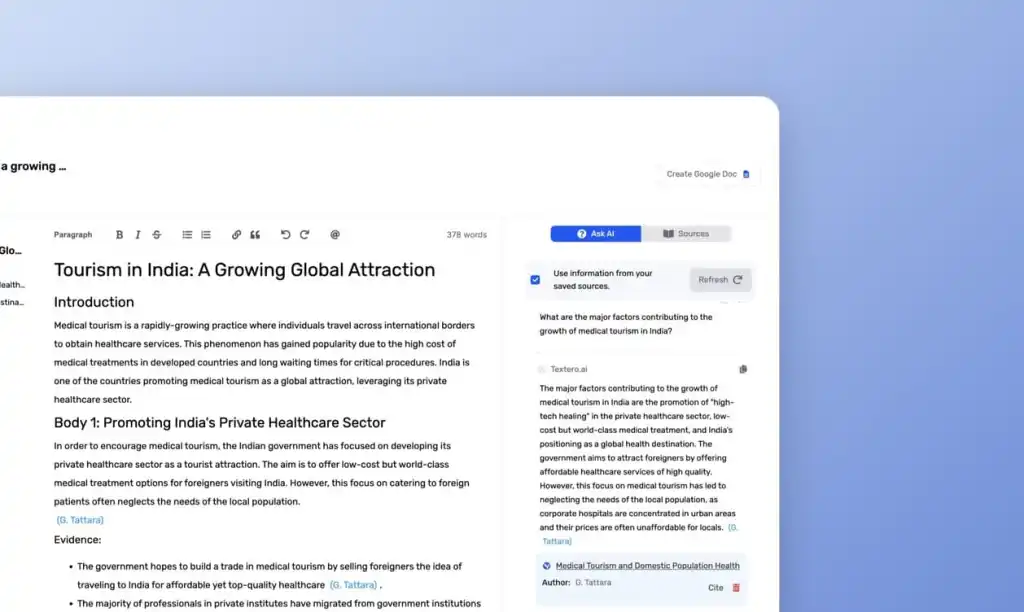
The Revolution in Essay Writer
AI is taking education by storm, and AI essay writer tools are becoming more popular than ever among students. They use advanced algorithms and natural language processing models to generate complete essays quickly. Combined with access to academic databases with papers from reputable authors, Textero AI is tailored to generate the highest-quality essays for any academic discipline, streamlining the essay writing process.
Trusted by Top University Students

Benefits of Textero AI Essay Maker
Students use our AI essay writer to simplify the essay-writing process by boosting productivity through quick generation of essays and research papers. This saves time and allows students to stay focused on the topic.
We use advanced natural language processing algorithms to ensure that content is error-free. Generated content has consistent grammar, tone, and adjustable style.
Our free AI essay generator guarantees plagiarism-free essays. It generates accurate citations for APA and MLA styles, ensuring that your research papers are adhering to the highest academic standards.
Essay writing tool ensures top quality of essays through access to an academic database with 215+ million papers. A combination of consistent tone, style, and coherence results in professional essays that adhere to academic standards.
With customizable settings for the generator, our essay writer tool offers unprecedented personalization to students. Provide the assistant with the details of your essay or outline to generate required paper.
Our AI essay writer tool gathers scientific sources from open scholarly bases with reputable articles. It also features an AI-powered assistant to improve the research process.
How Textero AI Essay Writer Works?

- Start writing for free
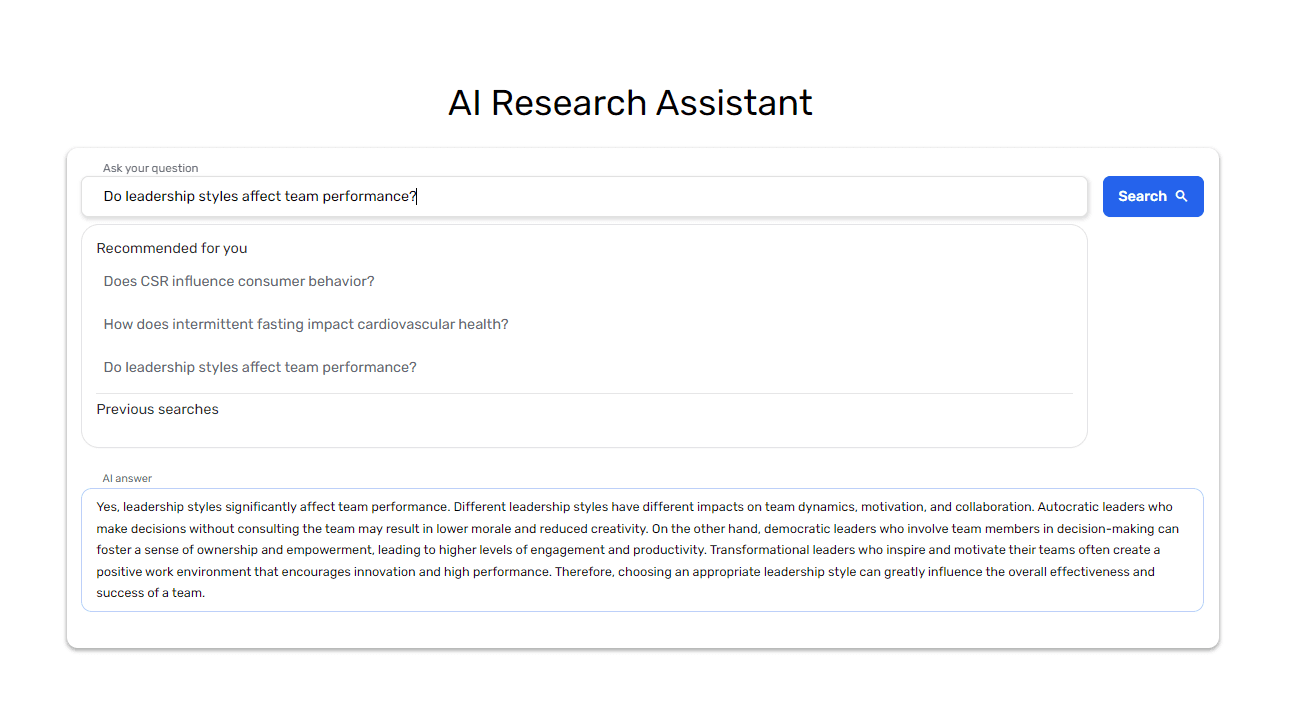
Your Personal AI Writing Coach
Write your essays faster with our AI essay maker and generator.
Find inspiration for your writer with Textero essay writing tool.
Polish your writing style by simplifying, expanding, shortening, or paraphrasing your text.
Find articles from reputable authors, generate citations, and conduct research.
Build compelling outlines with AI to streamline your writing process.
Upload your documents and texts to receive comprehensive summaries.
1M+ Users Review Textero AI Essay Writer

Jan 12, 2023
"As a student who struggles with planning papers and meeting deadlines, Textero AI was a life saver! The automatic outline and bibliography builder kept me structured, while the quick generation of introductions and conclusions accelerated my writing process. I finished two days early!"

Nov 21, 2022
"Facing a tight deadline for a major thesis paper, I used Textero's rapid generation of related evidence and rephrasing of my arguments to produce a well-cited, coherent paper in just a few days! It helped me synthesize tons of research efficiently."

Sep 15, 2023
"Textero essay writing tool quick brainstorming helped cure my writer’s block by sparking unique ideas I never considered. Seeing essay samples on various topics then effortlessly crafting an intriguing opening paragraph gave me creative confidence I've missed for years!"

Dec 1, 2022
"As a non-native speaker, Textero AI was a revelation. It offered vocabulary enhancements that made my essays sound natural. The Advanced Grammar and Style Corrections improved my writing dramatically, boosting my grades and confidence. Highly recommended for anyone seeking fluency in their academic writing!"

Aug 19, 2023
"Facing a tight deadline, I turned to Textero AI Essay Witing. Its quick essay generation feature produced quality content fast. It relieved my stress and helped me submit my assignment on time, with confidence. It's an invaluable tool for any student in a time crunch."

Oct 28, 2022
"Textero vocabulary suggestions enriched my academic essays, making them more articulate and impactful. The tool's ease of use and efficient features saved me countless hours, allowing me to focus on research. It's a fantastic aid for any academic writer."
- Intelligent Outlining Module – AI essay writer uses advanced algorithms to ensure coherent structure of generated texts. Resulting essays have a logical flow that expands on research topics.
- Dynamic Research Engine – our essay writing tool has access to academic research databases that are constantly updated. It prioritizes most recent sources to use in generated essays.
- Adaptive Writing Assistant – our AI assistant was trained on more than 215 million academic papers to provide suggestions to users’ content. It can be used to edit and revise generated texts.
- Multi-Format Citation Engine – users can select MLA and APA citation styles for their essays. AI essay writer will format sources according to the preferred citation style.
- Ask AI Function – look for academic sources relevant to your topic while working with the document. Users can ask AI a question and receive a detailed answer with relevant citations.
- Extensive Academic Database Access – Textero AI has direct access to the academic research paper database that is constantly updated. Sources used in generated essays adhere to academic standards.
- Contextualized Content Generation – AI essay writer tool generates contextually relevant essays and research papers based on the topic and instructions provided by the user.
- Anti-Plagiarism Shield – content generated by Textero AI is 100% plagiarism-free. It uses advanced algorithms to detect and eliminate plagiarism, ensuring that your assignments are credible.
- Narrative – narration of a story through events, often from the author’s perspective;
- Persuasive – the use of logical and reasonable arguments aimed at persuading readers to adopt the author’s point of view;
- Argumentative – presentation of a topic from several perspectives, favoring one side with evidence and reasoning;
- Expository – presentation of a topic in a straightforward manner by using facts and examples;
- Compare and contrast – description of similarities and differences between subjects to provide a nuanced perspective on the topic;
- Cause and effect – description of relationships between events to explain how different factors lead to a particular outcome;
- Definition – explanation of a idea, concept, or term with exploration of its interpretations;
- Expository – explanation of a topic in an unbiased manner through factual information and analysis.
Are you ready to write top-quality essay with Textero?
Boost Your Essay Writing Skills and Achievements with Textero AI
- No credit card required to start
- Cancel anytime
- 4 different tools to expolore
Save time. Get inspired.
Improve Your Academic Writing Skills and Performance With Textero AI. Discover your ultimate go-to assistant for academic writing. Use the power of AI to overcome writer’s block, find new ideas, and elevate your writing experience with Textero.io.
© 2024 Textero.io, Inc. All rights reserved.

- AI Essay Generator
- Free AI PDF Summarizer
- AI Outline Generator
- Privacy Policy
- Terms & Conditions
- Cancelation Policy
- Affiliate Program
- Affiliate Program Terms
Latest Portfolio
Need any help or looking for an agent.
Advanced AI Essay Writer
20,000 AI-powered essays generated daily
Write unique, high-quality essays in seconds
See it for yourself: get a free essay by describing it in 5 words or more, instantly generate any essay type.
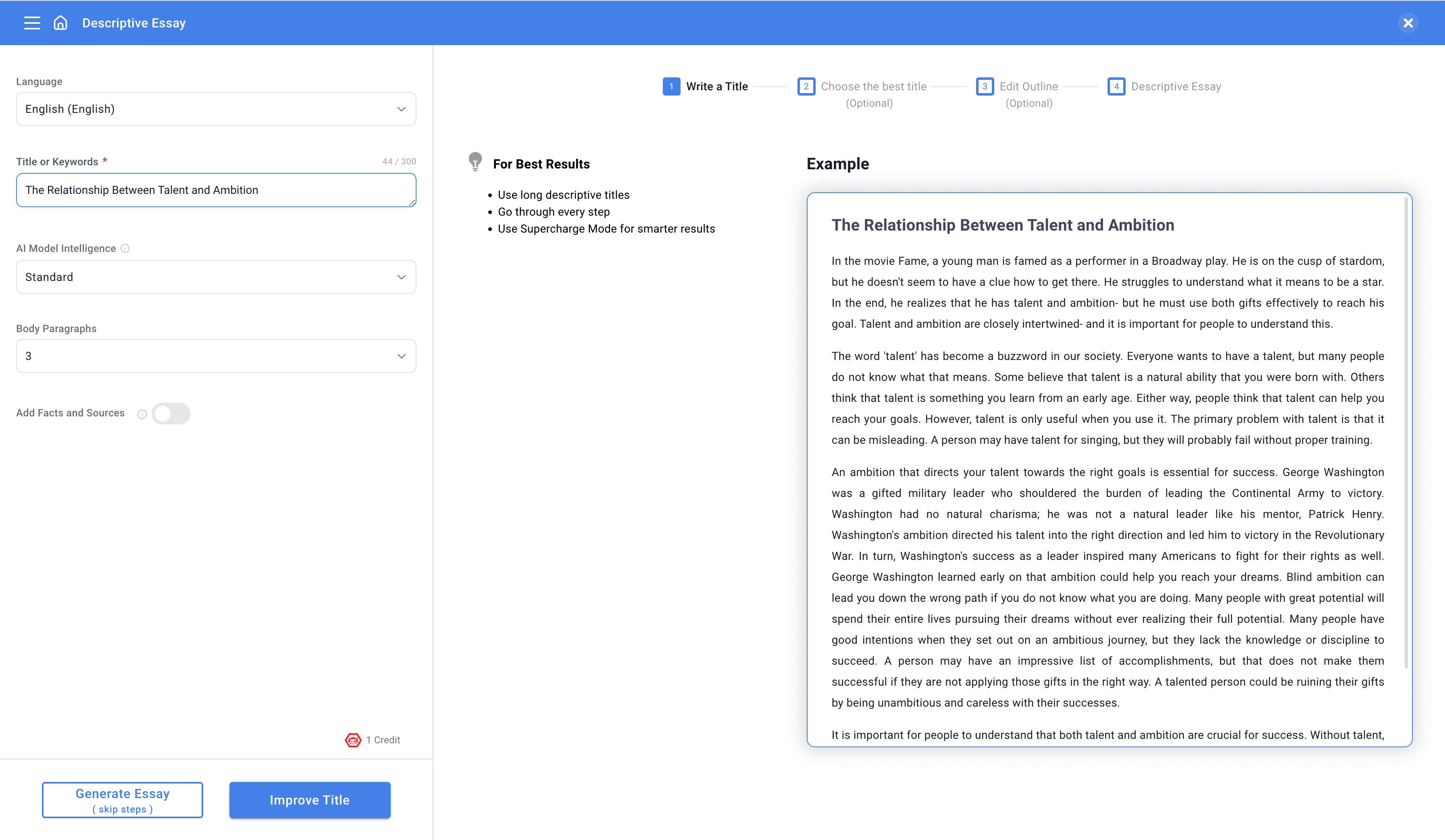
Get your content after just few words , or go step by step.
Full control of each step
Check the references
Edit your references using popular reference types like APA or MLA
How Smodin makes Essay Writing Easy
Generate different types of essays with smodin, instantly find sources for any sentence.
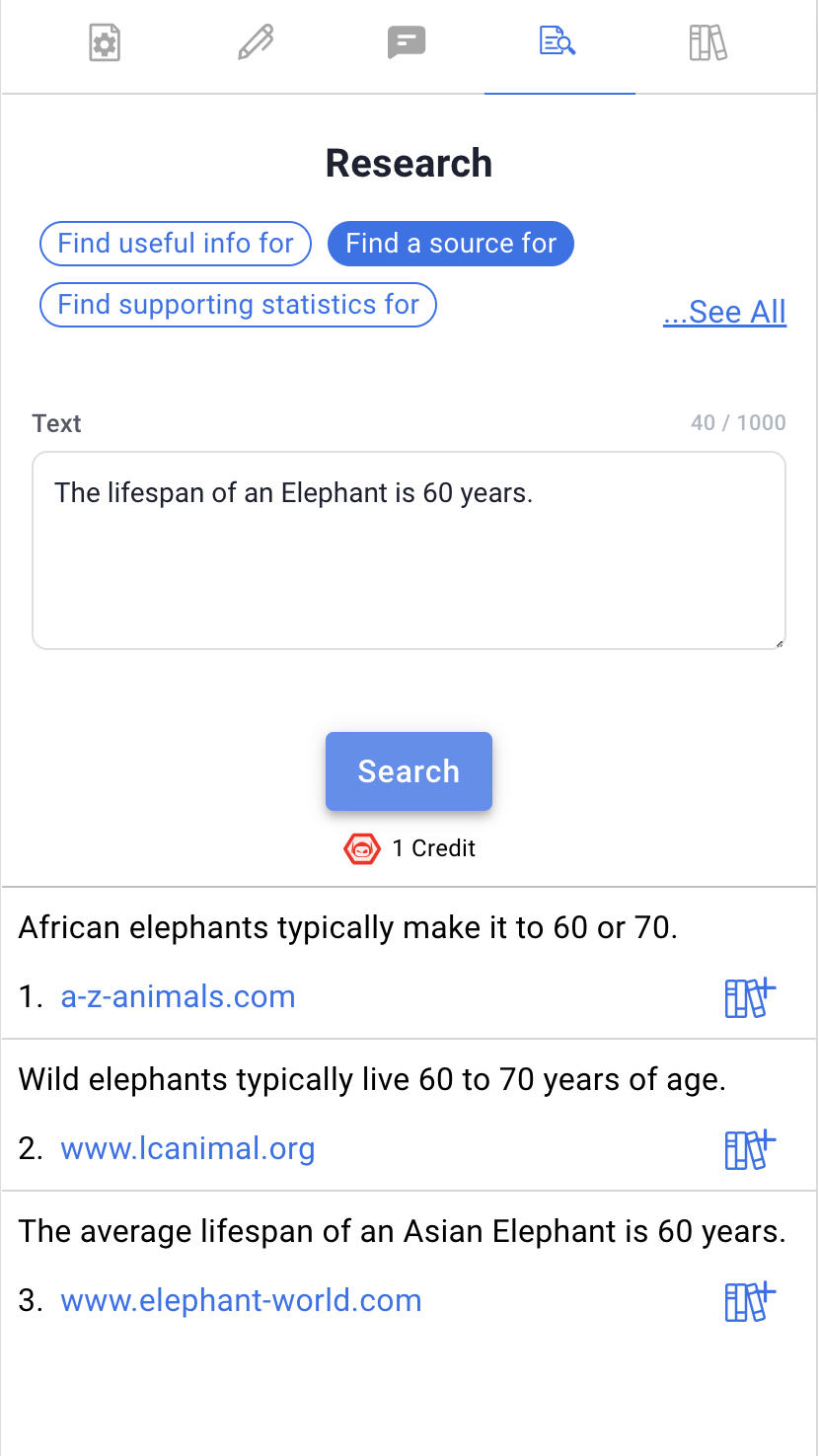
Our AI research tool in the essay editor interface makes it easy to find a source or fact check any piece of text on the web. It will find you the most relevant or related piece of information and the source it came from. You can quickly add that reference to your document references with just a click of a button. We also provide other modes for research such as “find support statistics”, “find supporting arguments”, “find useful information”, and other research methods to make finding the information you need a breeze. Make essay writing and research easy with our AI research assistant.
Easily Cite References
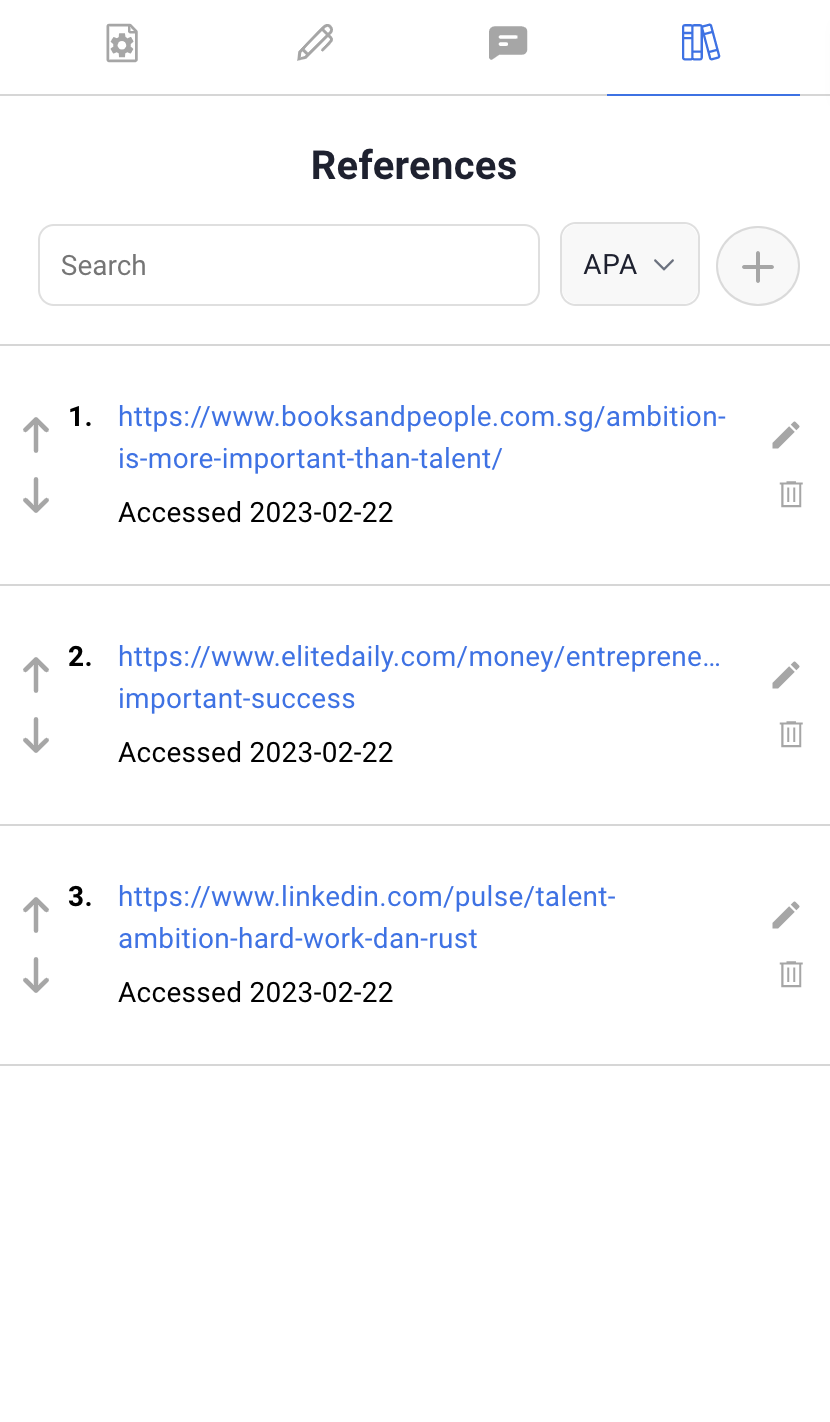
Our essay generator makes citing references in MLA and APA styles for web sources and references an easy task. The essay writer works by first identifying the primary elements in each source, such as the author, title, publication date, and URL, and then organizing them in the correct format required by the chosen citation style. This ensures that the references are accurate, complete, and consistent. The product provides helpful tools to generate citations and bibliographies in the appropriate style, making it easier for you to document your sources and avoid plagiarism. Whether you’re a student or a professional writer, our essay generator saves you time and effort in the citation process, allowing you to focus on the content of your work.
Produce Better Essays than ChatGPT
Our essay generator is designed to produce the best possible essays, with several tools available to assist in improving the essay, such as editing outlines, title improvements, tips and tricks, length control, and AI-assisted research. Unlike ChatGPT, our AI writer can find sources and assist in researching for the essay, which ensures that the essay is backed by credible and relevant information. Our essay generator offers editing assistance and outlines to improve the structure and flow of the essay. This feature is especially useful for students who may struggle with essay organization and require guidance on how to present their ideas coherently. Another advantage of our AI essay writer over ChatGPT is that it is designed explicitly for essay writing, ensuring that the output is of high quality and meets the expectations of the instructor or professor. While ChatGPT may be able to generate essays, there is no guarantee that the content will be relevant, accurate or meet the requirements of the assignment.
Easily Avoid Plagiarism
Our AI generated essays are 100% unique and plagiarism free. Worried about AI detection? Worry no more, use our AI Detection Remover to remove any AI Plagiarism produced from the essay generator.
Testimonials
Millions of users love Smodin's AI Writing Features
Smodin.io is an exceptional app that offers a range of outstanding features designed to help users with their research and content creation needs. One of the app's most impressive features is the Article 2.0, which generates high-quality articles and provides references for further study. The app's ChatIn feature and Research Paper generator are also incredibly unique, allowing users to conduct thorough research on the internet and find genuine paraphrased papers. One of the most impressive aspects of Smodin.io is its customer service team. The team is highly responsive, always available to help, and goes the extra mile to understand users' issues and offer solutions. This level of commitment to customer satisfaction is commendable and sets Smodin.io apart from its competitors. Another notable feature of Smodin.io is its continuous improvement. Every time you use the app, you'll notice new features that have been added based on feedback and recommendations. This level of attention to user feedback is remarkable, and it shows the app's developers' commitment to ensuring that Smodin.io remains the best in the market. I highly recommend Smodin.io to anyone looking for a reliable and efficient research and content creation tool.
I like this app. This app is useful mainly for student
Nice product
© 2024 Smodin LLC
AI Essay Writer
Customize outline, loved by over 3 million students and academics across the world, see what samwell can do.
Example of essays and research papers written with Samwell AI
Analysis of Marketing Mix Strategies for Wal-Mart Company
Performance Evaluation of Portfolio Managers of Mutual and Hedge Funds
Continuity and Change in USA 1950’s to Present
Write, Cite, Learn
Samwell makes writing and researching for essays easy, fast, and fun while delivering the best results
AI Essay Writer by SamWell is a free essay generator that helps you write all types of academic essays in seconds without any plagiarism issues.
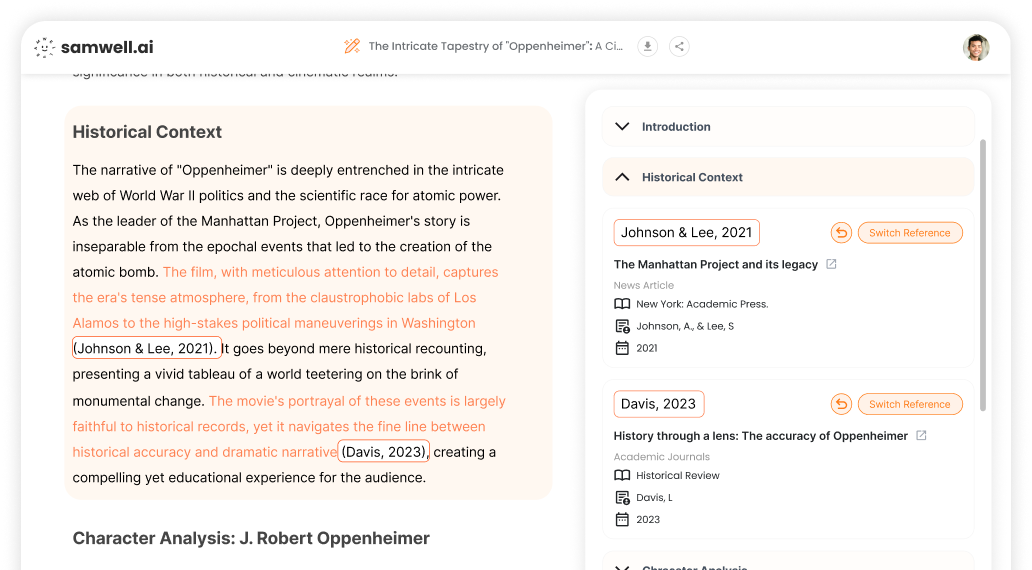
Add References
Need a reference that better aligns with your essay's requirements? Samwell AI provides a variety of verified citations and sources, ensuring your references are tailored and diverse
High Standard
Academic Integrity
Samwell AI champions academic integrity, offering suggestions that inspire true creativity within academic standards. Our tool simplifies information access and writing with AI, while keeping the focus on learning - the heart of our mission.
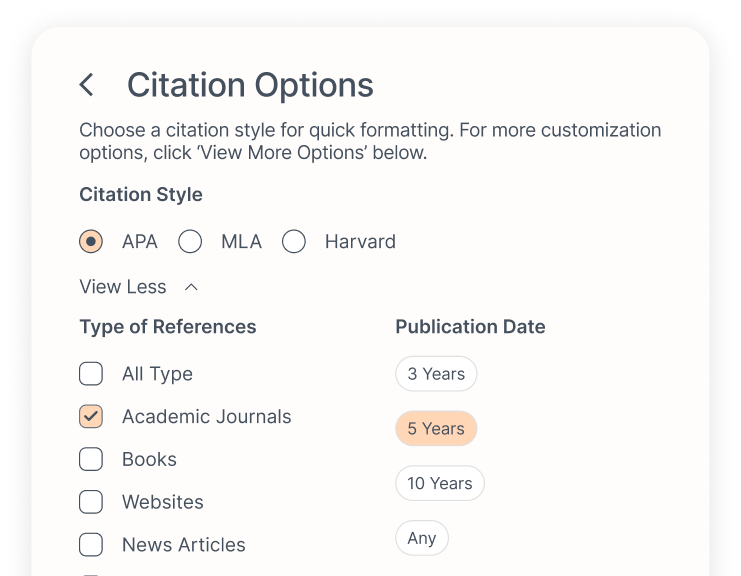
Personalization
Tailored Essays Based On Your Interests
Discover insights into how the highlights of your new research paper connect with your existing knowledge.
Three million empowered writers
Samwell has written over 3.5 billion words from essays to market analysis to blog posts.
Samwell is the app I would have DREAM of when I was in high school, bachelor, master and PhD. So fast and intuitive. We can learn about 10 topics in a day now.
In a world where writing doesn't mean much anymore, Samwell AI offers academics and students what really matters today: quick access to information, references, overview. Introducing it to my students right away.
I considered ChatGPT to be a helpful writing assistant. However, upon discovering Samwell AI, I was amazed. Its capabilities exceeded my expectations by tenfold.
What’s the point to write with AI, now that AI writes for you. Samwell AI is the smartest AI I’ve see, it helps to learn faster and have access to information in a second. No bullshit of you writing, this isn't the point anymore
Samwell provide the best references on the market, the longer essay too (up to 50 pages). Everything in a second and (finally) design friendly. Big up!
A big thank you to Samwell Ai for genuinely saving my life. 🙏❤️
Samwell AI is truly astounding as it generates the entire first draft of your master's thesis or any research paper instantaneously. Furthermore, it provides various options for references and in-text citations, along with a guided tour of the paper. It's absolutely mind-blowing!
Samwell, the AI-driven helper for academic research, has recently improved and become perfect.
Samwell AI is a dream, it guide you through the research paper, you have access to the best accurate sources, it recommend Youtube videos to highlight some important topic. It’s huge!! Congrats!
You’re in control
Choose the package that suits you best. You can switch anytime.
1,000 words
15,000 words per month
90,000 words per month
200,000 words per month
Start Writing Your Free Essay!
More about samwell.
Have a question that needs answering? Our team is here to help! Get in touch with us via email at [email protected]

Your Best AI Essay Writing Copilot
Take Your Essay Writing To The Next Level With EssayGPT
Streamline your essay content workflow here. Save time having to research, cite, or plagiarism-check your work using our powerful AI essay writing copilot!

Extensive Features Offered By Our AI Essay Writer
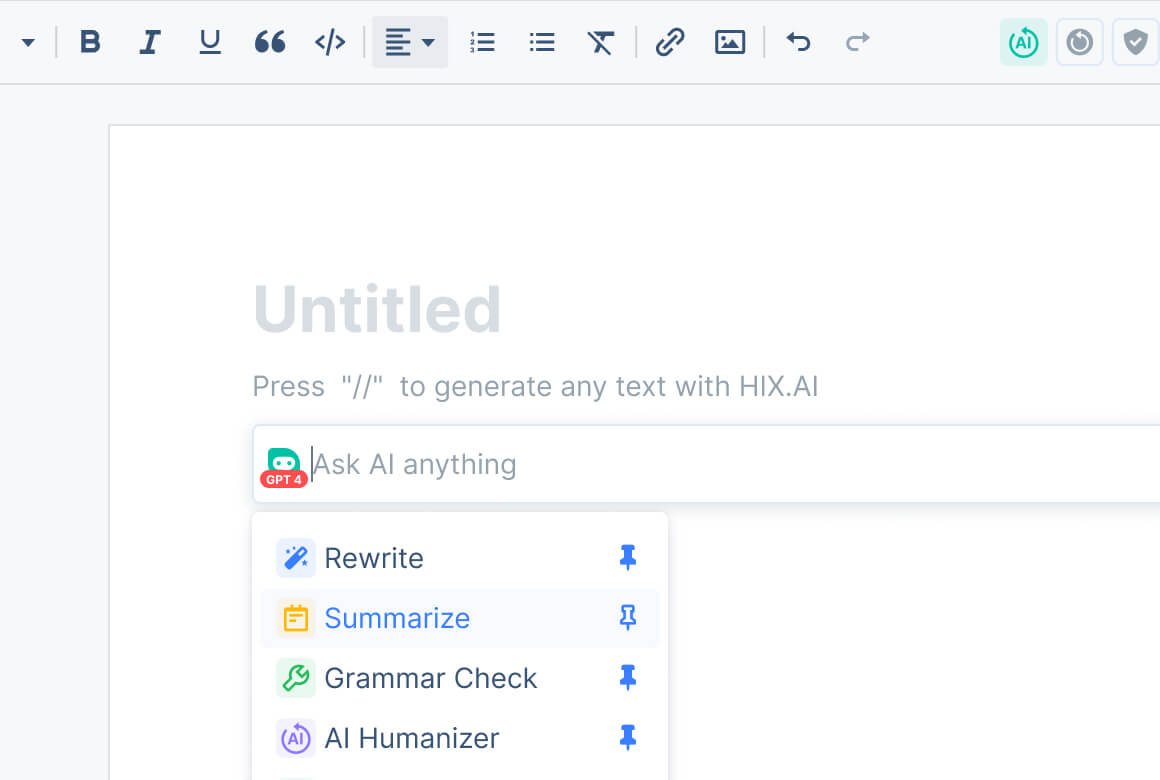
Create & Enhance Any Essay Content
Get full-length essay drafts on any topic or subject in a flash. Once you type //, EssayGPT can help you instantly craft new content from scratch. You can also rewrite, summarize, or expand any existing essay in one click.

Research & Fact-Checking Capabilities
EssayGPT can help speed up the research and fact-checking process, as it is linked to a vast network of scholastic databases and academic publications. Access detailed and up-to-date information for your essay workflow.
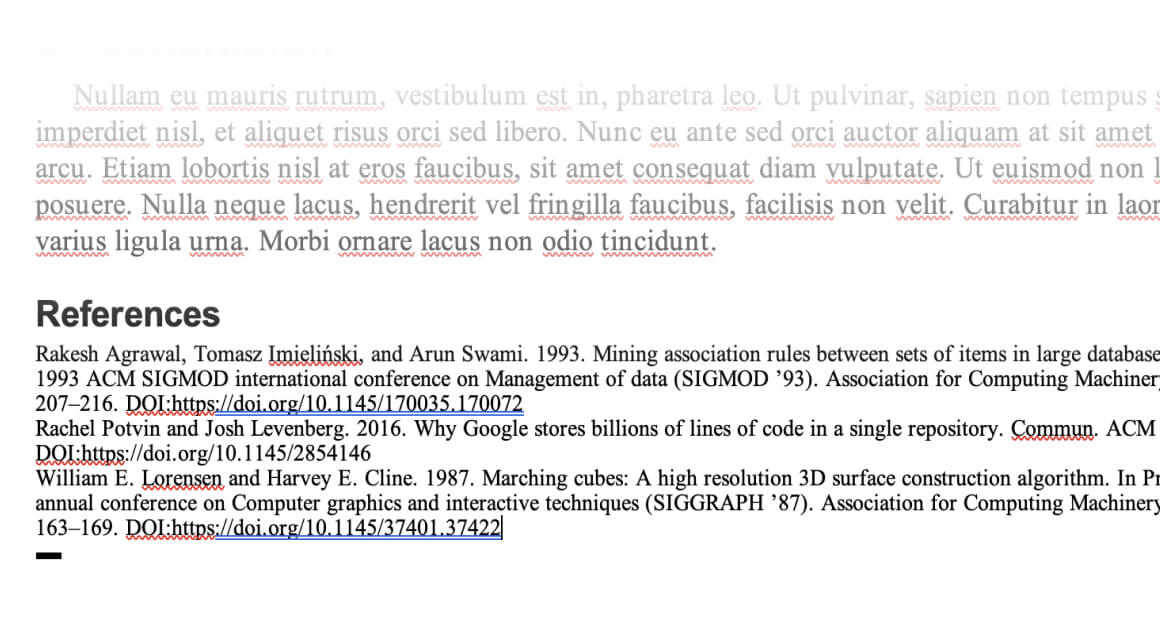
Custom Citation Assistance
Creating citations can be tedious and prone to errors. But you can now automate the entire process in seconds! With EssayGPT, you can instantly add accurate references in any style you want, be it in APA, MLA, Chicago, and more.
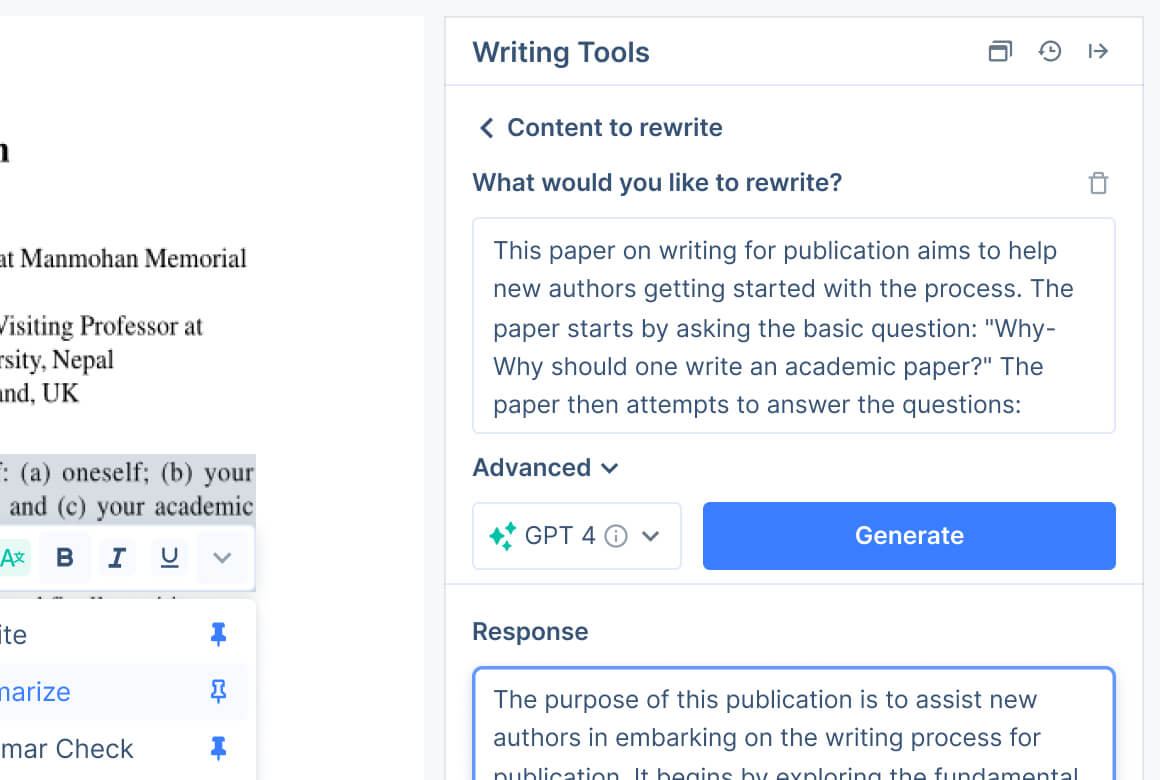
Automated Essay Completion
If you’re struggling with writer’s block, EssayGPT’s AI auto complete feature can help. It instantly analyzes the context of your existing writing before providing tailored and relevant suggestions that finish the rest of the essay on your behalf.
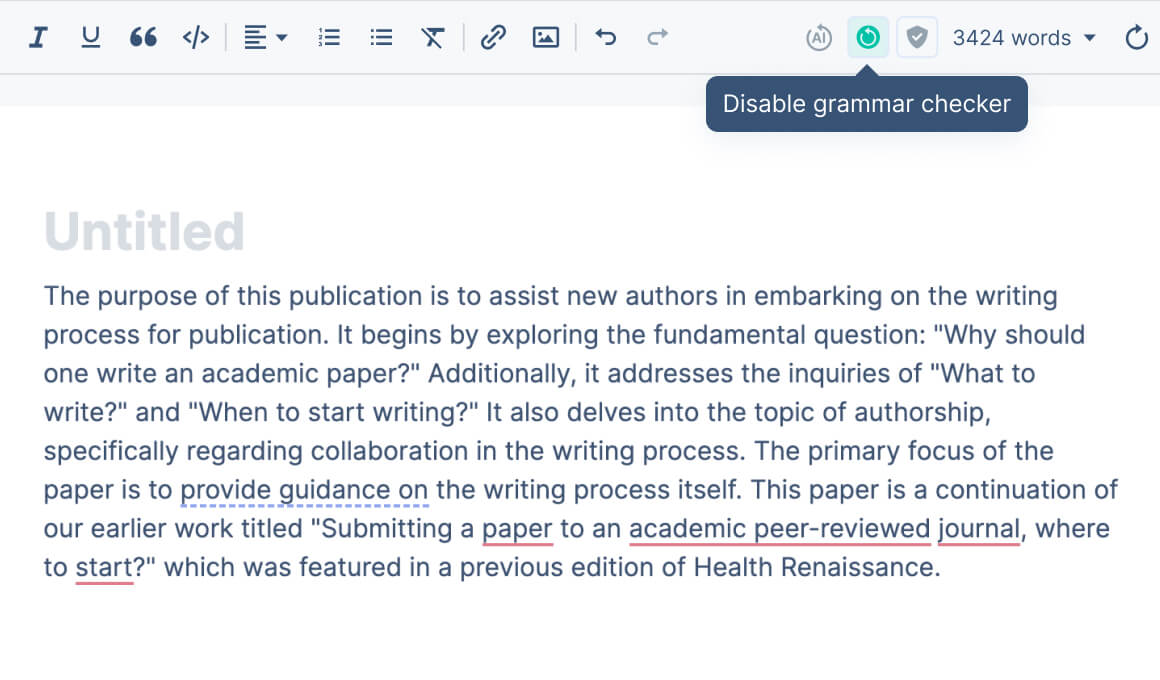
Comprehensive Grammar Checker
Say goodbye to any grammatical, syntax, or punctuation errors. EssayGPT will consistently ensure that your essay content will be coherent, clear, and easy enough for readers to understand.
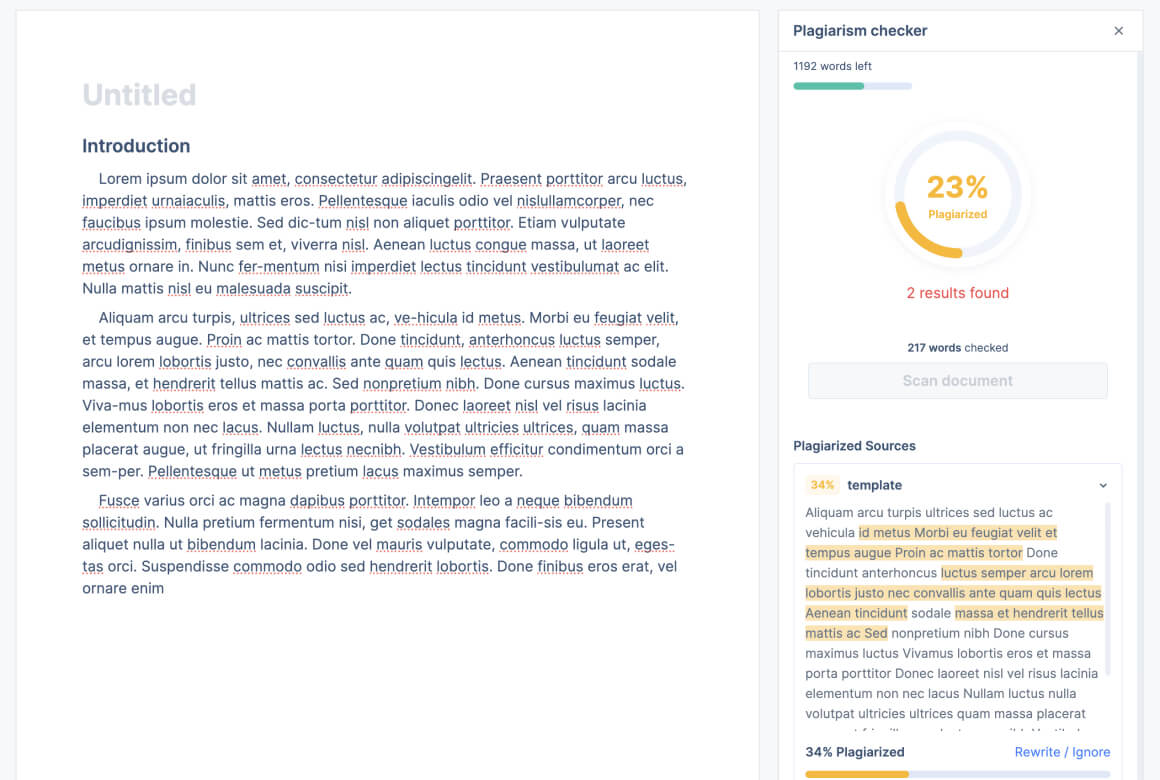
Accurate Plagiarism Checker
EssayGPT accurately scans your essay content to ensure it is 100% unique and not copied from anywhere. Make corrections and revisions before submission to avoid claims of plagiarism.
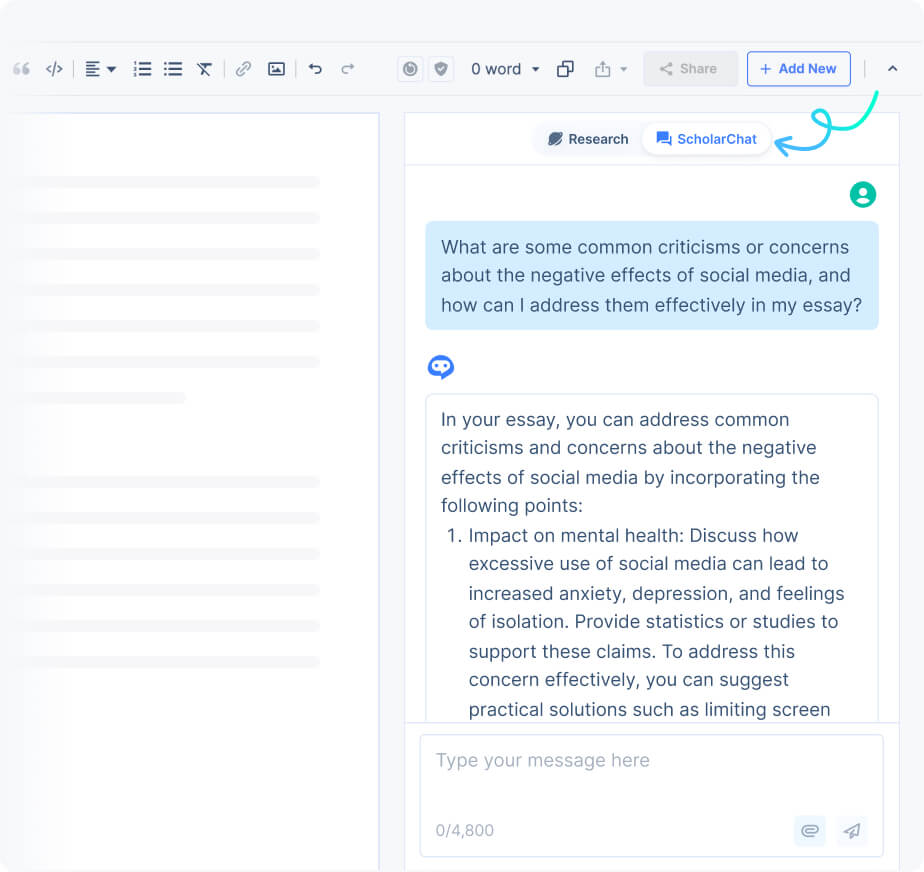
ScholarChat AI Assistant
ScholarChat is our AI chatbot designed to streamline any academic writing, editing, or research task. You can use this tool to generate essay content, fact-check information, translate papers, and so much more.
Generate Various Essays On Any Topic Using EssayGPT
EssayGPT is an extremely versatile AI essay writing assistant that accommodates a vast range of academic subject matter and topics such as:
Literature Analysis
Business Tactics
Scientific discourse
Health & Medicine
Historical Research
Social Studies
Environmental Assessment
In addition, EssayGPT is also capable of generating any type of essay content in any preferred writing format or style. This includes but is not limited to:
Narrative writing
Argumentative writing
Descriptive writing
Analytical writing
Expository writing
Comparison writing
Persuasive writing
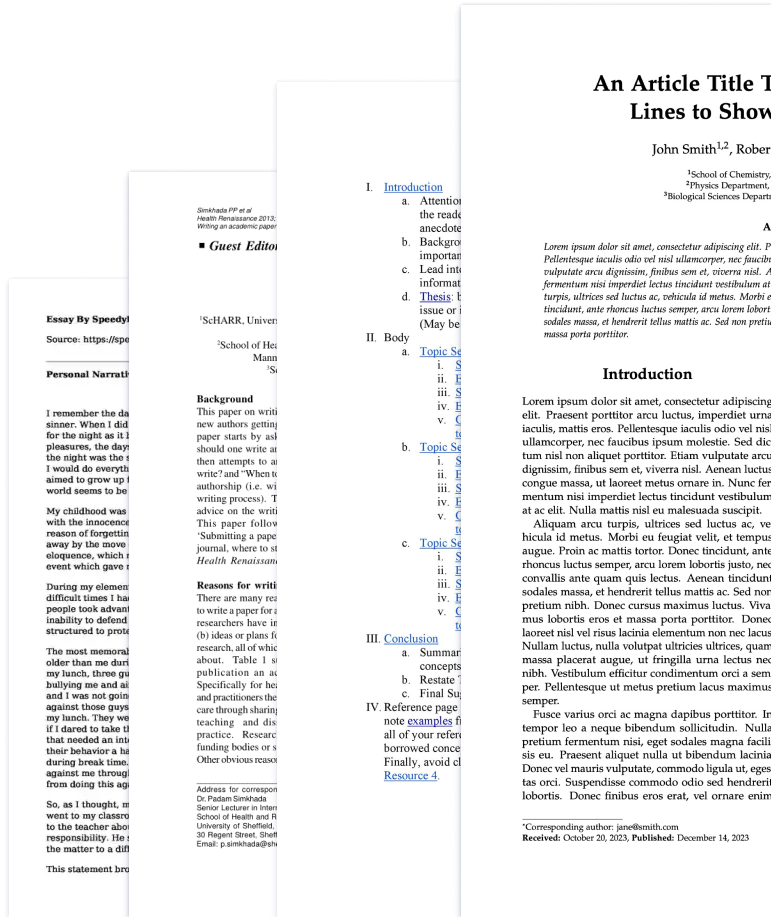
How Does EssayGPT Work?
You only need to follow the following three steps to produce a quality essay in seconds:
Step 1: Generate/Provide Your Essay
Type // to generate essay content such as an outline, introduction, abstract, and more. Alternatively, you can also copy/paste an existing essay into the portal for editing.
Step 2: Enhance Your Essay
Proceed to edit the draft using EssayGPT's advanced tools. You can utilize our 'Research' tool to pinpoint relevant publications to cite from in any field of study.
Step 3: Export Your Essay
If you are satisfied with the output, feel free to export the full-length essay in any desired format such as a local Word or PDF file. You can also export to Google Docs or WordPress.
What does EssayGPT do?
How does essaygpt optimize academic research.
EssayGPT is directly linked to a vast and up-to-date database that contains millions of academic papers, scholarly articles, scientific research studies, and more.
As such, it can instantly sift through and track down information published by well-respected authors in the academic community. This helps you streamline the research process, no matter what the subject matter or topic may be.
Is EssayGPT safe and secure enough to use?
Does essaygpt scan for signs of plagiarism, is there an ai auto-completion feature on essaygpt.
Yes. With EssayGPT, you no longer have to deal with writer’s block. There is an AI auto-completion option that you can access to instantly generate full-length completions that help extend your essay further.
Moreover, the added content will mirror your natural writing style and be contextually relevant. This ensures your intended message will still be conveyed as accurately as possible.
Can EssayGPT generate essays in multiple languages?

Take Full Advantage Of Our Powerful AI Essay Writer!
Make academic life easier using EssayGPT to generate and revise any essay in seconds!
Let’s write better essays.
Ai co-writer that helps students research, write, paraphrase and cite. effortlessly..
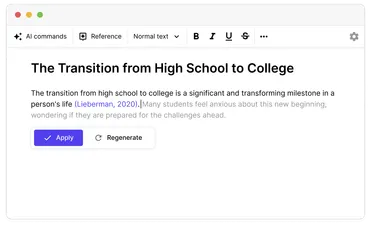
Used by 230,000+ smart students from
Mighty but simple AI co-writer
Use the power of ChatGPT while keeping your unique voice and originality
Outline Generator
Not sure how to start? Litero AI will suggest an outline for your specific topic.
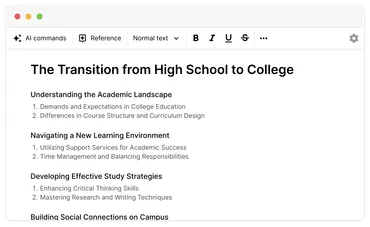
AI Autosuggest
Got writer's block? Litero AI will seamlessly suggest the next sentence or paragraph.
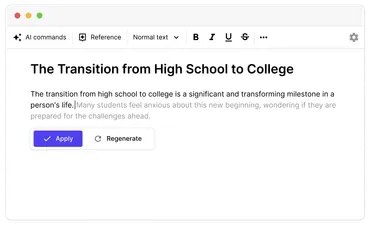
Citation tool
Add references and citations effortlessly in MLA, APA and other formats.
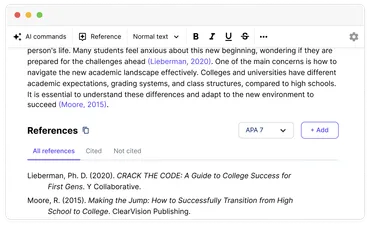
Built-in ChatGPT
We brought ChatGPT AI assistant right into your workflow. No more window switching.
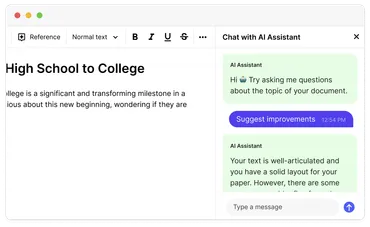
Ideal for faster writing and better grades
Save time with our built-in tools every student needs for a perfect essay.
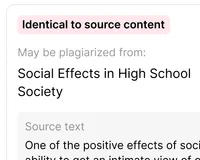
Plagiarism Detector
Check your text for plagiarism with accurate results.
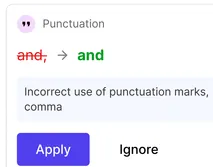
Grammar Checker
Find and fix issues with grammar, spelling, punctuation, and more!
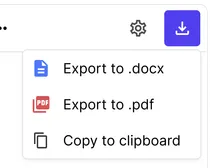
Easy export
Download your document in needed format: APA, MLA, etc
Try for free, upgrade anytime
- Instant access to all features
- Citation and references
- Grammar and plagiarism checker
- All AI commands
- Limited AI words per day
- Unlimited AI words
- Unlimited AI outline and draft helper
- Unlimited chat with AI assistant
- All AI comands

People love Litero. And talk about it.
Litero has an intuitive interface, which I like. Its autosuggestions elevated my papers to a whole new level. It's like having a personal writing mentor always at my side, guiding me toward clearer, more impactful expression.
David Brown
Georgetown University
Litero is my writing lifeline 📚✍️
Vikky Singh
Duke University
I never knew I needed Litero until I tried it for my homework. Now I use it at least 3 or 4 times a week to write faster.
Princeton University
Litero effortlessly handles issues with formatting, citations, and references, saving me hours of work on essays. Kudos to the team behind it!
Mason Wilson
University of Southern California
Big-big help with sources and adding references. I no longer need to worry about margins, citations - Litero helps me do it easier. I focus on the content of my papers, confident that the presentation will be top-notch. If you have some spare bucks the paid version is absolutely worth it.
Daniel Miller
Cornell University
Litero has become an essential instrument in my college life. Thank you for making my writing shine!
Emma Robinson
Washington University in St. Louis
As someone who strives for perfection in everything, Litero is a godsend. This tool helps me polish my academic writing to perfection, ensuring it meets the highest standards.
Stanford University
Discovering this tool is gold for my postgrad education. After trying the free version, I upgraded to the paid one, and I can't help but regret not using this writing AI earlier. It's the real deal!
University of Florida
Being a STEM student, I dread writing assignments and, frankly, anything connected to writing essays. Litero is perfect for me and anyone else with the same struggles.
Massachusetts Institute of Technology
Litero makes writing a breeze! A true lifesaver!
Ethan Mitchell
Rice University
I am all about efficient solutions and time-management. AI text tools from Litero streamline my studies. They help me improve my writing, saving me time and ensuring accuracy. Invaluable!
Nisha Reddy
Johns Hopkins University
I am glad I found Litero . It saved me so much time working on my articles and research with its smart and easy-to-use functionality. I'm impressed!
Chris Malkin
University of California, Berkeley
Securing a scholarship demands a high GPA and maintaining my high GPA is a top priority. I started using Litero and it helps me a lot with my homework.
Liam Anderson
Millenium high school
It's a game-changer for sure. I just can't believe how EASY it became to put my thoughts into writing: even when I have no idea how to start they have a tool for that! Litero 's been of great help so far and took a lot of stress away. Great AI tool for students.
Maria Robles
Boston University

AI Essay Writer & Assistant
Are you a student seeking to enhance your essay, assignment, or paper writing skills? Tired of low-quality tools that generate bad quality suggestions and don't help you put your own ideas out there? Look no further! Our AI essay writer is here to help you become a more confident and skilled academic writer.
Are you a student seeking to enhance your essay, assignment, or paper writing skills? Tired of low quality tools that proviLook no further! Jenni AI is here to help you become a more confident and skilled academic writer.

Loved by over 2 million academics

Trusted by Leading Universities
Join the ranks of students and researchers from prestigious institutions that trust us for essay writing support.

What Makes Our AI Essay Writer Different?

Overcome Essay Writer's Block.
Staring at a blank page? With our intuitive interface and AI-powered suggestions, you can generate essay prompts, assignment outlines, and paper topics, so you never have to battle writer's block alone.
Develop Your Essay Writing Skills, Don't Replace Them.
Our AI-powered assistant offers constructive feedback on your writing. It helps you identify areas for improvement, enhances the clarity of your arguments, and refines your writing style, making you a more effective communicator.

Academic Integrity Matters.
At Jenni AI, we take academic integrity seriously. Our tool is designed to enhance your writing abilities, not replace them. We do not generate entire essays, and we do not endorse cheating or plagiarism. Jenni is a legitimate essay writing assistant that provides you with the guidance and support you need to write your essays with citations.

How Does Our Essay Writing AI Work?
Sign up for free.
Create a free account and gain access to our powerful essay writer.
Enter Your Paper Or Essay Title
Write your essay, paper, or assignment topic or title to get started.
Receive Writing Suggestions
Our essay suggestion generator will give you insightful suggestions, helping you generate ideas and structure your essay effectively.
Edit and Enhance
Use the essay AI's feedback to edit and enhance your writing. Refine your essay until it's polished to perfection.
Generate & Research Essay Citations
Easily access citations, references and sources to ensure your essay is well-documented and academically sound.
What Our Users Say
Discover how Jenni AI has made a difference in the lives of academics just like you

· Aug 26
I thought AI writing was useless. Then I found Jenni AI, the AI-powered assistant for academic writing. It turned out to be much more advanced than I ever could have imagined. Jenni AI = ChatGPT x 10.

Charlie Cuddy
@sonofgorkhali
· 23 Aug
Love this use of AI to assist with, not replace, writing! Keep crushing it @Davidjpark96 💪

I started with Jenni-who & Jenni-what. But now I can't write without Jenni. I love Jenni AI and am amazed to see how far Jenni has come. Kudos to http://Jenni.AI team.

· 28 Jul
Jenni is perfect for writing research docs, SOPs, study projects presentations 👌🏽
Frequently asked questions
Does this ai essay writer generate entire essays, assignments, or papers, is there a free version, does it include a citation generator.
How does the writing process work?
Does it produce high-quality auto suggestions?
Does Jenni AI generate high quality essays?
Can I trust this AI Essay Assistant?
Choose us for your essay and never look back.
Learn how we stand out from other AI essay writers, generators and bots on the web
Feature Featire
COMPETITORS
Dynamic Writing Process
Employs a dynamic writing process driven by advanced algorithms and machine learning. Provides personalized guidance and support at every stage of your writing journey.
Often follow a linear essay generation process, lacking the adaptability and personalized assistance offered by Jenni AI.
Advanced Algorithms
Utilizes cutting-edge algorithms to understand your writing needs, adapting to your unique style and preferences over time.
May use basic algorithms that limit their ability to provide tailored writing assistance.
AI Assistant
Not an essay generator but a comprehensive AI assistant. Goes beyond generating content by offering guidance, essay outlines, and sources of inspiration.
Usually function as essay generators, focusing solely on content generation without providing comprehensive writing support.
User-Friendly
Offers an intuitive and user-friendly interface that simplifies the writing process. It's designed to be accessible to users of all backgrounds.
User interfaces can vary in terms of usability and may not be as user-friendly as Jenni AI's interface.
Incorporates natural language processing to understand and respond to your writing needs in a conversational manner.
May lack the depth of natural language processing capabilities found in Jenni AI, resulting in less interactive and effective interactions.
Ready to Elevate Your Essay Writing?
Join thousands of students, researchers, and academics who have experienced the benefits of Jenni AI, your ultimate AI academic essay writer. Sign up for a free account today and take your writing to the next level!
- Free Tools for Students
- MLA Citation Generator
Free MLA Citation Generator
Generate accurate citations in MLA format automatically, with MyBib!

😕 What is an MLA Citation Generator?
An MLA citation generator is a software tool designed to automatically create academic citations in the Modern Language Association (MLA) citation format. The generator will take information such as document titles, author, and URLs as in input, and output fully formatted citations that can be inserted into the Works Cited page of an MLA-compliant academic paper.
The citations on a Works Cited page show the external sources that were used to write the main body of the academic paper, either directly as references and quotes, or indirectly as ideas.
👩🎓 Who uses an MLA Citation Generator?
MLA style is most often used by middle school and high school students in preparation for transition to college and further education. Ironically, MLA style is not actually used all that often beyond middle and high school, with APA (American Psychological Association) style being the favored style at colleges across the country.
It is also important at this level to learn why it's critical to cite sources, not just how to cite them.
🙌 Why should I use a Citation Generator?
Writing citations manually is time consuming and error prone. Automating this process with a citation generator is easy, straightforward, and gives accurate results. It's also easier to keep citations organized and in the correct order.
The Works Cited page contributes to the overall grade of a paper, so it is important to produce accurately formatted citations that follow the guidelines in the official MLA Handbook .
⚙️ How do I use MyBib's MLA Citation Generator?
It's super easy to create MLA style citations with our MLA Citation Generator. Scroll back up to the generator at the top of the page and select the type of source you're citing. Books, journal articles, and webpages are all examples of the types of sources our generator can cite automatically. Then either search for the source, or enter the details manually in the citation form.
The generator will produce a formatted MLA citation that can be copied and pasted directly into your document, or saved to MyBib as part of your overall Works Cited page (which can be downloaded fully later!).
MyBib supports the following for MLA style:
| ⚙️ Styles | MLA 8 & MLA 9 |
|---|---|
| 📚 Sources | Websites, books, journals, newspapers |
| 🔎 Autocite | Yes |
| 📥 Download to | Microsoft Word, Google Docs |

Daniel is a qualified librarian, former teacher, and citation expert. He has been contributing to MyBib since 2018.
Create Human-like Essays with Our Undetectable AI Essay Writer
Generate plagiarism-free, undetectable essays that bypass AI detection with EssayFlow.
The Leading Undetectable AI Essay Writer That Beats AI Detectors

Are you worried that the essay generated by ChatGPT sounds robotic and might be detected as AI-generated?
EssayFlow, a premier undetectable AI essay writer, can help you generate essays that fully mimic human writing, empowering you to bypass the following AI detectors:
Originality.ai
Content at Scale
Trained on Millions of Human-Written Essays
Never settle for robotic ChatGPT content! Our AI model has been trained on millions of A+ grade, human-written essays and papers. We are pro at generating high-quality essays that sound and read just like real people wrote them.

Tackle Any Academic Task In a Breeze
In just a few minutes, create any kind of academic writing, including essays, research papers, dissertations, and literature reviews. Say goodbye to writer's block and sleepless nights.

Submit Original Work Safely
Our AI essay generator creates original essays that are free from copied content. You can comfortably bypass all plagiarism checks and ensure your academic integrity remains intact.

AI Detection Score Report
After the essay is generated, our all-inclusive AI detector, integrated with many renowned AI detectors in the market, including GPTZero and ZeroGPT, will collectively scan the content to provide you with comprehensive AI scores simultaneously.
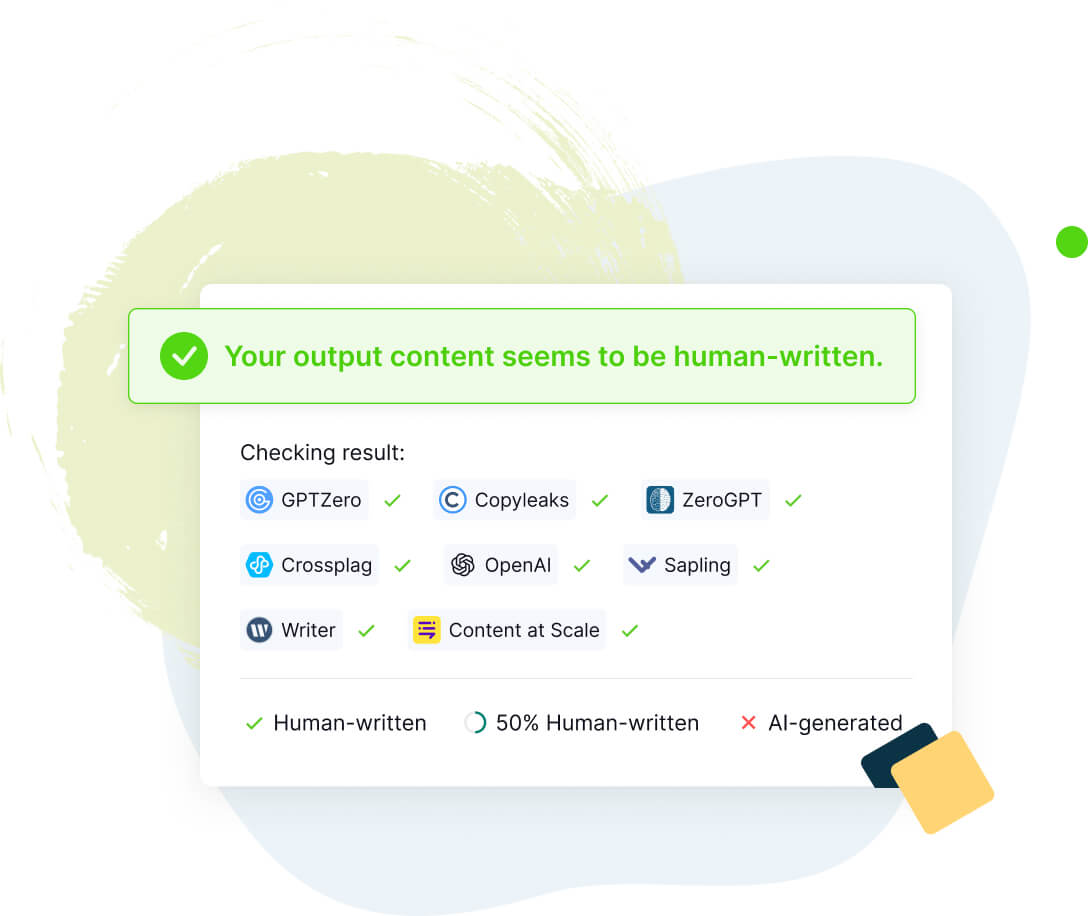
How Our AI Essay Generator Works
Provide All The Necessary Details
Type the topic of your essay and choose what type of essay you want, which language, and how long it should be.
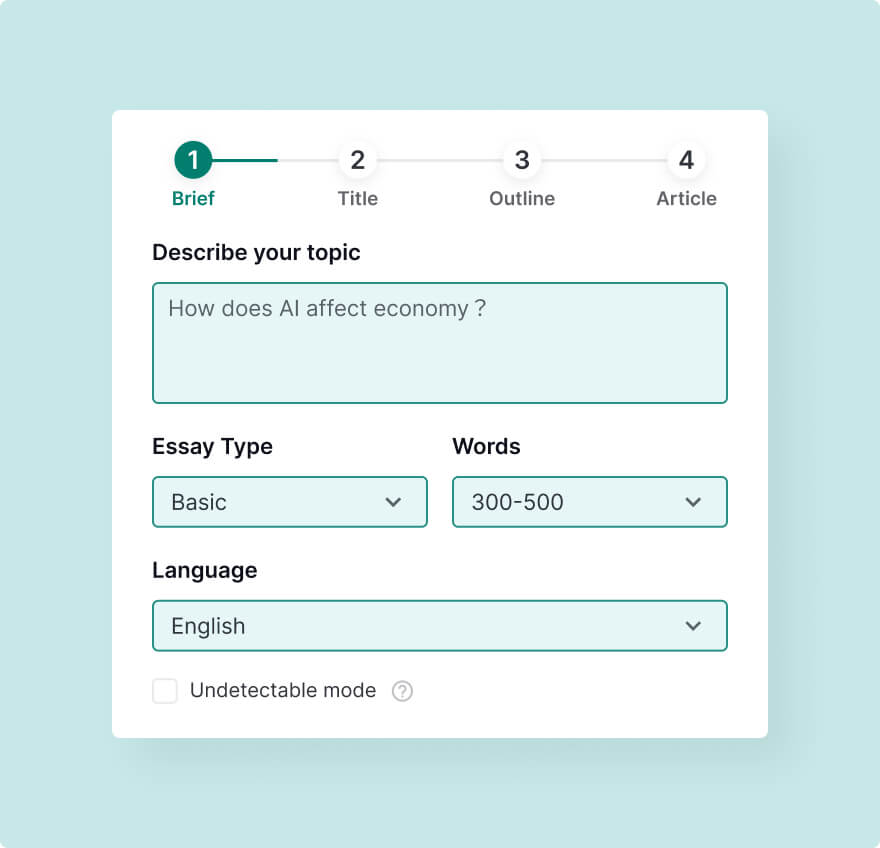
Use "Undetectable" Mode (Optional)
If you want, you can use the "Undetectable mode". This will make sure the essay looks like a human wrote it and won't be detected by AI.
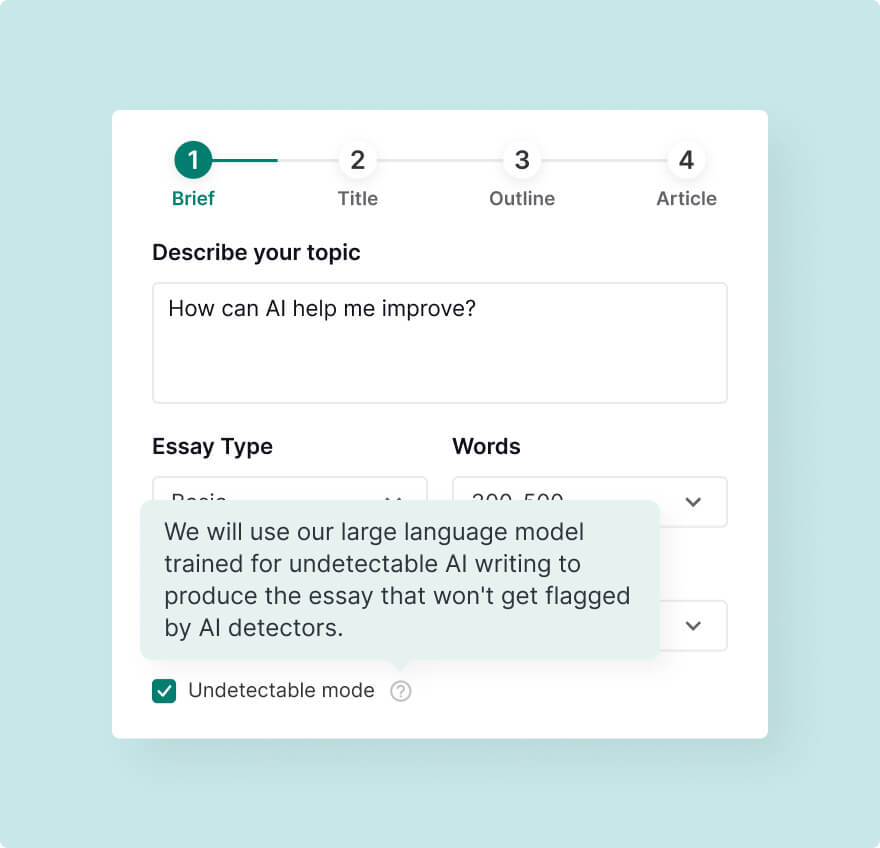
Generate & Check Detectability
Generate your essay in a single click or step-by-step, and upon completion, check its AI score with our built-in AI detector.

What is EssayFlow?
EssayFlow is an undetectable AI essay writer that allows you to generate essays that closely resemble human writing. It is dedicated to helping students confidently submit their work while adhering to ethical standards and avoiding penalties from academic institutions.
How can this AI essay generator help me bypass AI detection?
We have trained our AI model on millions of human-written essays. Because of this, we can produce essays that faithfully replicate the structure, style, and content of human writing. No more need to use AI detection remover to humanize AI essays.
Additionally, we have an all-inclusive AI detector in place to help you instantly scan your essay through leading AI detectors like GPTZero and ZeroGPT to get comprehensive results! So, with EssayFlow, you can confidently submit essays that bypass AI detection.
How to use this undetectable AI essay writer?
Begin by providing the necessary topic and relevant keywords that you want the essay to focus on. Then, tick the option "undetectable mode" to ensure that the generated essay closely resembles human writing.
You can generate the full essay in one click, or proceed to let the AI automatically generate titles and outlines before generating the final draft.
After generating the essays, EssayFlow will indicate whether it can bypass a few leading AI detectors like GPTZero, Turnitin and ZeroGPT. This information will be displayed conveniently in one place for your convenience.
Besides providing a way to bypass AI detectors, what makes EssayFlow stand out?
EssayFlow helps you generate essays step by step and allows you to review and modify titles, outlines, and content, ensuring you can add a personalized touch to the final essay.
Additionally, it creates original content that passes plagiarism checks with ease. This guarantee enables students to confidently submit their work without the risk of facing penalties for plagiarism.
Are the AI-generated essays by EssayFlow completely plagiarism-free?
Yes, our advanced algorithms and training processes incorporated into the system ensure the creation of original content that is free from any form of plagiarism.
What language does this AI essay generator support?
Our AI essay generator supports over 50 languages. Whether you need an essay in English, Spanish, French, German, Mandarin, Arabic, or many other languages, the free essay generator is equipped to assist you in your desired language of choice.

Try Our Undetectable AI Essay Writer Now!
Are you looking to write original, human-like, and high-quality essays to turn in with confidence? EssayFlow ticks all of these boxes. Try it for free today!
0 Characters
0 Sentences
AI Essay Writer
AI Essay Writer by Editpad is a free essay generator that helps you write narrative, persuasive, argumentative and descriptive essays online in seconds.
How to use AI Essay Writer by Editpad?
To use Editpad's AI Essay Writer, you need to follow these simple steps below:
- Type or paste your essay topic or requirements in the input box provided.
- Select the required essay length and writing tone.
- You can also select the " Add References " option if required.
- Click on " Write My Essay " button.
- After that, our essay generator will automatically generate your essay and provide results in the output box.
Other Tools
- Plagiarism Checker
- Paraphrasing Tool
- Reverse Text - Backwards Text Generator
- Small Text Generator - Small Caps / Tiny Text
- Upside Down Text Generator
- Words to Pages
- Case Converter
- Online rich-text editor
- Grammar Checker
- Article Rewriter
- Invisible Character
- Readability Checker
- Diff Checker
- Text Similarity Checker
- Extract Text From Image
- Text Summarizer
- Emoji Translator
- Weird Text Generator
- Stylish Text Generator
- Glitch Text Generator
- Cursive Font Generator
- Gothic Text Generator
- Discord Font Generator
- Aesthetic Text Generator
- Cool Text Generator
- Wingdings Translator
- Old English Translator
- Online HTML Editor
- Cursed Text Generator
- Bubble Text Generator
- Strikethrough Text Generator
- Zalgo Text Generator
- Big Text Generator - Generate Large Text
- Old Norse Translator
- Fancy Font Generator
- Cool Font Generator
- Fortnite Font Generator
- Fancy Text Generator
- Word Counter
- Character Counter
- Punctuation checker
- Text Repeater
- Vaporwave Text Generator
- Citation Generator
- Title Generator
- Text To Handwriting
- Alphabetizer
- Conclusion Generator
- Abstract Generator
- List Randomizer
- Sentence Counter
- Speech to text
- Check Mark Symbol
- Bionic Reading Tool
- Fake Address Generator
- JPG To Word
- Random Choice Generator
- Thesis Statement Generator
- AI Content Detector
- Podcast Script Generator
- Poem Generator
- Story Generator
- Slogan Generator
- Business Idea Generator
- Cover Letter Generator
- Blurb Generator
- Blog Outline Generator
- Blog Idea Generator
- Essay Writer
- AI Email Writer
- Binary Translator
- Paragraph Generator
- Book Title generator
- Research Title Generator
- Business Name Generator
- AI Answer Generator
- FAQ Generator
- Active Passive Voice Converter
- Sentence Expander
- White Space Remover
- Remove Line Breaks
- Product Description Generator
- Meta Description Generator
- Acronym Generator
- AI Sentence Generator
- Review Generator
- Humanize AI Text
Supported Languages
EN ES BR DE
- Refund Policy
Adblock Detected!
Our website is made possible by displaying ads to our visitors. please support us by whitelisting our website.
What do you think about this tool?
Your submission has been received. We will be in touch and contact you soon!
- Buy Custom Assignment
- Custom College Papers
- Buy Dissertation
- Buy Research Papers
- Buy Custom Term Papers
- Cheap Custom Term Papers
- Custom Courseworks
- Custom Thesis Papers
- Custom Expository Essays
- Custom Plagiarism Check
- Cheap Custom Essay
- Custom Argumentative Essays
- Custom Case Study
- Custom Annotated Bibliography
- Custom Book Report
- How It Works
- +1 (888) 398 0091
AI Essay Writer to Improve Your Writing Process
How does an ai essay writer work.
Simplify your essay writing process by following these easy steps:
Enter your topic
Write down what your essay is about, how long it should be, and your academic level.
Generate the Essay
Press the "Start Writing" button to get an essay according to your requirements.
Customize the text
To enhance your essay for academic success, add more details. Select the type of essay, the number of references, the formatting style, and other specifics.

Frequently Asked Questions
What is the best free ai essay writer.
CustomWriter is the leading free AI essay writer. Simply input a title and word count, and it will deliver a top-notch essay complete with citations.
How to get AI to write an essay?
The process is simple: Enter your essay topic. Pick how many words you want. Choose the writing level, like if it's for college or high school. Press "start writing" and wait for your essay. If it's not what you want, you can give more details, ask for references, change the number of words, and do other things to make it better.
How to make an AI essay undetectable?
Use paraphrasing tools, or add some obvious grammar errors to sneak past AI checks. However, the most effective method is to review the essay on your own and manually rewrite the required sections. This approach ensures your essay is entirely unique.
Can AI essay writers produce essays of high quality?
Our essay writer has been trained on millions of academic papers to guarantee the utmost quality in generated content. The database is consistently updated to enhance user experience for the future.
Is my data and information safe with CustomWriting.com?
Certainly! Ensuring user privacy is our top priority, and we implement rigorous data protection measures. We use the latest security technology and follow global rules to keep your essays and information safe with us.
How does the AI Essay Writer make sure it follows the rules for academic formatting?
Our AI essay writer tool currently supports generating citations in MLA and APA formats. Users can select the desired style in the corresponding field. This allows them to provide further instructions on formatting.
What types of essays does AI essay generator write?
Our free essay writer can write various types of essays. Some of these include argumentative, descriptive, narrative, persuasive, definition, reflective, research, critical, and analytical essays.
If you have any questions or suggestions, please feel free to reach out to us. We're constantly striving to improve!
- Better Quality
- Plagiarism free
- More Personalization
- Accurate information
- Fresh and reliable sources
- Professional writers
- 24/7 support
- 100% confidentiality
- Plagiarism-free
- Any complexity

We use cookies on our website to give you the most relevant experience by remembering your preferences and repeat visits. By clicking “Accept All”, you consent to the use of ALL the cookies. However, you may visit "Cookie Settings" to provide a controlled consent.
MLA citation generator
Sit back and relax. Let SciSpace give you instant and accurate MLA citations
Browse among 9000+ citation styles
Writing for a different discipline or publication? Have an appropriate citation style for them all.
Here's how SciSpace's MLA citation generator works
Creating your references is about as easy as it gets with SciSpace. Just follow these simple steps below:
| Select the source material | Journal article, Conference proceeding, Webpage, Book |
| Select the citation format | MLA 9th edition |
| Edit or add metadata via these methods | 1. Copy and paste raw text from any website 2. Use the search bar to find the source by URL, DOI, or ISBN 3. Input field values manually |
| Click 'Generate Citation' | Get MLA in-text citations and works cited entries in seconds — without any ads |
| Save and export citation | Download the output in BibTeX format or copy the text for free |
Generate accurate MLA citations
Paste content or enter the source URL and our AI will scan, capture, and categorize the relevant info to generate in-text and bibliographic in seconds — no more missing details or manually filling boxes and fields.
Proceed with confidence
Submit assignments, papers, or essays confidently, knowing our AI is trained on the latest MLA guidelines and manuscripts. You no longer have to sift the internet for MLA citation examples.
Refer to different types of sources
Cite websites, books, book chapters, articles, and press releases, in MLA style — with just a few clicks. More sources to be supported soon.
Save progress and come back later
Don't wait till the writing process is complete to start working on your bibliography. Generate MLA style in-text citations and reference entries as you go and save them, so you don't miss any sources.
Easily export to BibTeX
Using LatTeX for document preparation? No problem, export the MLA formatted output directly as BibTeX files and add them to your project without hassle.
Complete your bibliography for free
Our MLA citation generator is free to use. So, you can turn your sources into accurately formatted in-text and bibliographic MLA citations without spending anything.
Enjoy a clutter-free experience
No ads or annoying pop-ups to deal with — just a top-of-the-line, AI-powered MLA citation generator that takes you through the whole process in fewer steps and less time.
Speed up in-text citation
Let our AI take care of MLA in-text citation formatting so you can focus on writing. Our AI scans what you've already written and offers relevant autocompletion suggestions as per the MLA style.
Why our citation generator is the easiest and most effective way to cite sources?
Wondering which citation generator should you go for? Here is a list of features that you should look out for, so you can make an informed decision.
| Features | Citation Generator by SciSpace | Citation Generator by Quillbot | Citation Generator by Scribbr | Citation Generator by Cite this for me | Citation Generator by Citation Machine | Citation Generator by Easybib |
|---|---|---|---|---|---|---|
| Capture information from the Internet | Fully | Partially | Partially | Partially | Partially | Partially |
| Autoformatting | Yes | Partially | Partially | Partially | Partially | Partially |
| Export | BibTeX, Clipboard | Word, Clipboard, CSL-JSON, BibTeX | Word, LaTeX, Clipboard | Word | Word | Word |
| Cost | Free | Free | Free | After 15 references $8.54/mo | Free version + paid $9.95/mo | Free version + paid $9.95/mo |
| Ad-Free | Yes | Yes | Yes | No | No | No |
Common questions about referencing your sources in MLA style
Questions around citing in the MLA style are fairly common, especially among students and new researchers. So, we've answered some of the most frequently asked ones below.
- 1 . What is MLA citation? MLA citation format is a citation style developed by the Modern Language Association. It is one of the most widely used forms of citation in both the academic and non-academic world today. The MLA Style Citation is common in humanities, especially for literature and language studies and social sciences, with many journals adopting the style to cite sources. A writer can cite in two ways using the MLA format; in-text, which is included in the body, and bibliography, which comes on the work’s cited page.
In-text citation -
Bibliography -.
- 3 . What is an MLA works cited page? A works cited page is a dedicated page at the end of research where the writer lists out all the references in bibliography style. Citations on the works cited page have to be detailed and should match the references included in the body of the text. MLA works cited entry example: Johns, Scott. “Making the Impossible Possible.” *People Magazine*, April 2021, pp. 56-61.
- 4 . How to reference a website in MLA format? Here's what a MLA citation of a website would look like: Use the following format when you’re citing a webpage in the MLA format: Last name, First name. “Title of Web Page.” Title of Website, Publisher, Date published, and URL. MLA website citation (works cited entry) example: Reith, Jerry. “The Physics Behind the Formation of Auroras.” The Scientific American, 24 Apr. 2018, www.scientificamerican.com/article/the-physics-behind-the-formation-of-auroras/
- 5 . How to cite a book in MLA format? When you’re citing a book in MLA style, use the format - Last Name, First Name. Title of Book. Publisher, Publication Date. MLA books citation (works cited entry) example: Johnson, Jane. Climate Change: Understanding the Facts. 3rd ed., Oxford University Press, 2021
- 6 . How to cite a journal article in MLA format? The set style for citing a journal article in MLA style is - Last name. First Name. "Title of Article." Publication, Day Month Year, pages. If you’re citing an online publication, replace ‘pages’ with ‘URL.’

Work cited entry example in MLA format:
Reference list entry example:, bibliography entry example:.
- 8 . How to use et al. in MLA citation format? In MLA citation, et al. are used to cite three or more authors. Include the first author’s name followed by “et al.””
- 9 . How to cite a YouTube video in MLA format? When citing YouTube or other online videos, be as descriptive as possible to help your readers locate the video. This typically includes the creator's full name or screen name, the publication date, the title of the video, the hosting website (e.g., YouTube), and the URL for the video. This will ensure that readers can easily access and watch the video and understand the context of your reference.”” Here’s how to cite a YouTube video in MLA format; PBS NewsHour. “What is the First Amendment?” YouTube, 7 Apr. 2022, youtu.be/t_FoD7SeHOQ.
- 10 . How to cite multiple authors in MLA format? It can be confusing and verbose to include every author’s name for one source. Thus, MLA guidelines suggest you use “et al.” after the first author’s name.
- 11 . How to cite a pdf in MLA format? There are no specific MLA guidelines on how to cite a pdf. Depending on the type of material a pdf is (book, chapter, article), use the appropriate format to cite the document.
- 12 . Is SciSpace's MLA citation generator completely free? Absolutely! Our MLA Citation Generator is totally free, and better yet, it's super accurate compared to other citation style generators — particularly for MLA citation style.
- 13 . Do you follow the latest MLA format guidelines? Yes, the format complies with the MLA format guidelines. Our AI model is trained on the latest data. If there are any changes to the guidelines, we'll change our algorithm accordingly.
- 14 . What are the other citation generators offered by SciSpace? Besides the MLA style, we also offer citation generators for Harvard, Chicago, IEEE, APA, and 9000+ other citation styles. All of them use the latest data and technology to ensure your citations are accurate and up-to-date.
Explore our range of reading and writing tools
Ease up your research workflow with SciSpace's cohort of exciting AI tools
SciSpace Copilot
Paraphraser, ai detector, citation generator.
How do I cite generative AI in MLA style?
The MLA’s method for citing sources uses a template of core elements —standardized criteria that writers can use to evaluate sources and create works-cited-list entries based on that evaluation. That new technologies like ChatGPT emerge is a key reason why the MLA has adopted this approach to citation—to give writers flexibility to apply the style when they encounter new types of sources. In what follows, we offer recommendations for citing generative AI, defined as a tool that “can analyze or summarize content from a huge set of information, including web pages, books and other writing available on the internet, and use that data to create original new content” (Weed).
- cite a generative AI tool whenever you paraphrase, quote, or incorporate into your own work any content (whether text, image, data, or other) that was created by it
- acknowledge all functional uses of the tool (like editing your prose or translating words) in a note, your text, or another suitable location
- take care to vet the secondary sources it cites (see example 5 below for more details)
See below for specific examples. And keep in mind: the MLA template of core elements is meant to provide flexibility in citation. So if you find a rationale to modify these recommendations in your own citations, we encourage you to do so. We’ve opened this post up for commenting, so let us know what you think and how you’re using and citing generative AI tools!
Using the MLA Template
We do not recommend treating the AI tool as an author. This recommendation follows the policies developed by various publishers, including the MLA’s journal PMLA .
Title of Source
Describe what was generated by the AI tool. This may involve including information about the prompt in the Title of Source element if you have not done so in the text.
Title of Container
Use the Title of Container element to name the AI tool (e.g., ChatGPT ).
Name the version of the AI tool as specifically as possible. For example, the examples in this post were developed using ChatGPT 3.5, which assigns a specific date to the version, so the Version element shows this version date.
Name the company that made the tool.
Give the date the content was generated.
Give the general URL for the tool. 1
Example 1: Paraphrasing Text
Passage in source, paraphrased in your prose.
While the green light in The Great Gatsby might be said to chiefly symbolize four main things: optimism, the unattainability of the American dream, greed, and covetousness (“Describe the symbolism”), arguably the most important—the one that ties all four themes together—is greed.
Works-Cited-List Entry
“Describe the symbolism of the green light in the book The Great Gatsby by F. Scott Fitzgerald” prompt. ChatGPT , 13 Feb. version, OpenAI, 8 Mar. 2023, chat.openai.com/chat.
Example 2: Quoting Text

Quoted in Your Prose
When asked to describe the symbolism of the green light in The Great Gatsby , ChatGPT provided a summary about optimism, the unattainability of the American dream, greed, and covetousness. However, when further prompted to cite the source on which that summary was based, it noted that it lacked “the ability to conduct research or cite sources independently” but that it could “provide a list of scholarly sources related to the symbolism of the green light in The Great Gatsby ” (“In 200 words”).
“ In 200 words, describe the symbolism of the green light in The Great Gatsby ” follow-up prompt to list sources. ChatGPT , 13 Feb. version, OpenAI, 9 Mar. 2023, chat.openai.com/chat.
While we’ve provided fairly detailed descriptions of the prompts above, a more general one (e.g., Symbolism of the green light in The Great Gatsby prompt) could be used, since you are describing something that mimics a conversation, which could have various prompts along the way.
Example 3: Citing Creative Visual Works
If you are incorporating an AI-generated image in your work, you will likely need to create a caption for it following the guidelines in section 1.7 of the MLA Handbook . Use a description of the prompt, followed by the AI tool, version, and date created:

Fig. 1. “Pointillist painting of a sheep in a sunny field of blue flowers” prompt, DALL-E , version 2, OpenAI, 8 Mar. 2023, labs.openai.com/.
You can use this same information if you choose to create a works-cited-list entry instead of including the full citation in the caption (see MLA Handbook , sec. 1.7).
Example 4: Quoting Creative Textual Works
If you ask a generative AI tool to create a work, like a poem, how you cite it will depend on whether you assign a title to it. Let’s say, for example, you ask ChatGPT to write a villanelle titled “The Sunflower” that—you guessed it!—describes a sunflower and then quote it in your text. Your works-cited-list entry might look like this:
“The Sunflower” villanelle about a sunflower. ChatGPT , 13 Feb. version, OpenAI, 8 Mar. 2023, chat.openai.com/chat.
If you did not title the work, incorporate part of or all of the first line into the description of the work in the Title of Source element:
“Upon the shore . . .” Shakespearean sonnet about seeing the ocean. ChatGPT , 13 Feb. version, OpenAI, 8 Mar. 2023, chat.openai.com/chat.
For guidance on using descriptions and text from the work itself in the Title of Source element, see the MLA Handbook , 5.28 and 5.29.
Example 5: Citing Secondary Sources Used by an AI Tool
You should also take care to vet the secondary sources cited by a generative AI tool—with the caveat that AI tools do not always cite sources or, when they do, do not always indicate precisely what a given source has contributed. If you cite an AI summary that includes sources and do not go on to consult those sources yourself, we recommend that you acknowledge secondary sources in your work.
For example, let’s say that you ask Bing AI to explain the concept of the political unconscious, citing sources, and it provides the following answer:

Let’s say that you then decide to quote from the final sentence. You need to click through to the source listed in the note in order to get more information than just a URL for the source. There, you will read the following:

Now, you can treat Oxford Reference as your source since Bing AI was merely a research conduit to the source (see MLA Handbook 5.34 for more information). If for some reason you want to treat a source cited in a generative AI tool as an indirect source–and you know it is, in fact, the source for the information provided by the AI, follow the guidance in section 6.77 of the MLA Handbook .
1. At the time of writing this post, ChatGPT doesn’t have a built-in feature to create a unique URL to the conversation. However, an outside tool like the Chrome extension ShareGPT can generate such a link. If you use that type of outside tool, include the unique URL that the tool generates instead of the general URL.
DALL-E allows users to download the AI-generated images they create or generate a publicly-available URL that leads to an image. If you choose to create a shareable link for an image you generate with DALL-E (or other similar AI image generators), include that unique URL that leads to the image instead of the general URL.
Works Cited
MLA Handbook . 9th ed., Modern Language Association of America, 2021. MLA Handbook Plus , 2021, mlahandbookplus.org/.
Weed, Julie. “Can ChatGPT Plan Your Vacation?” The New York Times , 16 Mar. 2023, www.nytimes.com/2023/03/16/travel/chatgpt-artificial-intelligence-travel-vacation.html.
41 Comments
Caitlin ratcliffe 21 march 2023 at 06:03 pm.
Thank you for this guidance about ChatGPT! This is very timely and helpful. Can you please confirm the order of the core elements in your guidance here? Specifically the "Publisher" element and the "Date" element. Thank you!
Your e-mail address will not be published
Laura Kiernan 22 March 2023 AT 12:03 PM
Thank you for your question about the order of the Publisher and Date elements. We have corrected this post to show that the Publisher element should be before the Date element in works-cited-list entries.
Christiana Salah 22 March 2023 AT 06:03 PM
While you say to vet the sources, which broadly covers this, it might be helpful to explicitly state in your guide that ChatGPT will invent plausible-looking sources. These fake citations use the names of real publication venues and sometimes the names of real scholars in the correct field.
For example, I tested ChatGPT by asking for a paragraph on a recent novel citing a peer-reviewed source. It created a plausible citation for an essay in a paywalled new issue of a relevant journal. Only by investigating the author's name and finding them not to exist was I able to tell the citation was invented. It appears ChatGPT will cite real sources when it finds such, but invent one if it does not.
Diana Tsang 22 March 2023 AT 08:03 PM
Thank you for this timely reference! Could you kindly confirm if the format of the Version Date (Feb. 13 version) is different from the MLA's usual format of Date (not "13 Feb." version) on purpose?
Laura Kiernan 23 March 2023 AT 11:03 AM
Thank you for pointing out that error. We have corrected this post so the date in the Version element follows the day-month-year date style: 13 Feb. version.
As the Title of Container (e.g. ChatGPT) is not a just description. Shall it be italicized in the works cited entry?
Thank you for pointing out that error. ChatGPT should be italicized because it is the name of a piece of software, so we have corrected this post to reflect that.
Tarn 28 March 2023 AT 09:03 PM
Should DALLE-E be italicised in the above example too?
Fig. 1. “Pointillist painting of a sheep in a sunny field of blue flowers” prompt, DALLE-E, version 2, OpenAI, 8 Mar. 2023, labs.openai.com/.
Laura Kiernan 29 March 2023 AT 09:03 AM
Thank you for alerting us to that error. Yes, that AI tool name should be italicized, so we have corrected the post to reflect that. We have also corrected the spelling to be DALL-E .
Carine Ndzewiyi 03 January 2024 AT 12:01 AM
Thank you for being my eye opener. Yes DALL- E should be italicized
Amy Curtis 24 March 2023 AT 12:03 PM
How would you suggest to cite ChatGPT when using it to summarize personally generated data sets? For example in lab experiments, or observational data.
Christian Schmidt 03 April 2023 AT 04:04 PM
Thank you for these guidelines. Question on Example 3 "Citing Creative Visual Works". You are NOT suggesting to include the link to a retrievable/published version of such an image, instead you advice to provide the general URL of the tool (here: labs.openai.com/). But: You are currently the only Style provider who has touched on the retrievability issue in a bit more differentiated way (in your note to Example 5). You are even mentioning workarounds like ShareGPT for text there, which is appreciated. But I don't understand, why you would not suggest the same for images, since some of the image creation tools even allow for publishing them - no workaround needed. OpenAI's DALL-E does it (example: https://labs.openai.com/s/jrbn6Dl8aRTDvS4Kobny33n2), and others like Midjourney allow for that, too. Any reason why that is not included here?
Laura Kiernan 04 April 2023 AT 10:04 AM
Thank you for bringing that to our attention. We have updated the note in the post to acknowledge that if someone chooses to create a shareable link for an image generated with DALL-E (or other similar AI image generators), that unique URL should be included instead of the general one.
Anna Mills 11 April 2023 AT 05:04 PM
Here's a suggestion for a way to foreground the human critics who are the real sources of the ideas about the symbolism of the green light in the above Fitzgerald example:
Unknown human authors statistically remixed by ChatGPT, 13 Feb. version, OpenAI, 8 Mar. 2023, chat.openai.com/chat. “Describe the symbolism of the green light in the book The Great Gatsby by F. Scott Fitzgerald” prompt.
Thomas Basbøll 12 April 2023 AT 04:04 AM
Christiana's point above deserves an answer. In example 2, you provide a screenshot of such "hallucinated" references, but you suggest quoting GPT uncritically describing it as a "list of scholarly sources". Is this good practice?
E A 15 June 2023 AT 02:06 AM
Remind your students that GPT is not a scholarly source, nor a source that's any better (actually worse) than wikipedia. It's a generative pre-trained transformer. I can't find anything in the AI literature or specs that is directing it to use actual, scholarly, or peer-reviewed, or even actual sources, versus "faking" them, as we've seen in the comments, above. AI takes no responsibility for this, nor do, it seems, its "handlers" (originators, developers). This is parallel to when Zuckerberg, et. al, took no responsibility for FB postings pushing disinformation (esp re elections) , Russians trolls, or credibility. None, zero, zip, whatsoever. AI also cannot be "accused" of plagiarism or dishonesty, nor does it need to experience any consequences, unlike humans. It is responsible for nothing, and to no one. Humans, however, are.
Davis Oldham 17 April 2023 AT 10:04 AM
I agree with Thomas and Christiana. The first source cited in Example 2, Bruccoli, does not appear to exist, from what I can see in the table of contents for the cited container: https://worldcat.org/title/10020427
Bruccoli is an actual Fitzgerald scholar but the cited title does not appear in the cited collection of critical essays.
I think it's imperative that a resource on citing chatGPT should address this.
GPT is not a scholarly source, nor a source that's any better (actually worse) than wikipedia. It's a generative pre-trained transformer. I can't find anything in the AI that is directing it to use actual, scholarly, or peer-reviewed, or even actual sources, versus "faking" them, as we've seen in the comments, above. AI takes no responsibility for this, nor do, it seems, its "handlers" (originators, developers). AI also cannot be "accused" of plagiarism or dishonesty, nor does it need to experience any consequences, unliked humans. It is responsible for nothing, and to no one. Humans, however, are.
Liz G 15 June 2023 AT 03:06 AM
I agree, but, the AI developers and those "riding the AI wave" (in the jargon of our IT people at our college and the Deans) don't really care to address such niceties. Harold Bloom was right, at least, about the internet, it was the beginning of the end.
B Shaw 13 July 2023 AT 05:07 PM
Chiming in to support this point! After doing some research, none of the articles cited in the screenshot appear to exist. This is a really important point to make to students. Based on the large amount of non-existent books and articles students (and faculty) have been requesting at my library, the fact that ChatGPT gives fictional sources is not widely known!
Rebecca Danielle Armentrout 01 May 2023 AT 10:05 AM
Does google translate when I am writing my own words in google translate to translate it in English need to be cited?
Dirk 09 May 2023 AT 09:05 PM
Hey, I was wondering, if students only used ChatGPT to rewrite their original work using more sophisticated academic terminology to express ideas more clearly and fix grammar and spelling mistakes. Do they need to cite this? If so, how do they need to do this?
Christa 22 August 2023 AT 09:08 AM
I came here for this guidance, too, and so far the most I can find is "acknowledge all functional uses of the tool (like editing your prose or translating words) in a note, your text, or another suitable location." So it seems that we need to guide our students to do this, based on our own preferences or a class discussion to arrive at a norm about it.
Christa 22 August 2023 AT 10:08 AM
I found this from below: Example: “Rewrite the following text “Harry Potter and the Sorcerer’s Stone: Chapter 1” in 8th grade language” prompt. ChatGPT, 13 Feb. version, OpenAI, 12 Jun. 2023, chat.openai.com/chat.
To transfer this example into a possible way to cite editing/revision help from GPT that students are seeking, we might ask the student to document the editing prompts that they fed into the GPT to help them. It seems weird to put them in the Citations page though, because they'd be citing themselves, but that may be the thing to do?
Anon 15 May 2023 AT 11:05 AM
How would I cite ChatGPT or Google Bard if I were to use it for editing and brainstorming? What would I put in my bibliography? Every single prompt or just a statement of acknowledgement?
Sarah Pierce 12 June 2023 AT 04:06 AM
One thing we are seeing in class is that students are using ChatGPT to rewrite texts in easier-to-use language. We are discouraging them from summarizing/paraphrasing because that is not student-thinking. In this case, the prompt would include the source text (and could possibly be longer than the original essay in the works cited). therefore we have adapted the MLA citation to include the title of the source text rather than the source text itself.
E.g. Note: If your prompt includes a source text (e.g. the entire first chapter of Harry Potter), use the title of the source text in the citation instead of the text itself.
Example: “Rewrite the following text “Harry Potter and the Sorcerer’s Stone: Chapter 1” in 8th grade language” prompt. ChatGPT, 13 Feb. version, OpenAI, 12 Jun. 2023, chat.openai.com/chat.
Patty Hude 07 September 2023 AT 10:09 AM
Hi! Why wouldn't the title of the source (the prompt) be capitalized in title case as is usual for MLA titles? (ex. “In 200 words, describe the symbolism of the green light in The Great Gatsby” is not in title case)
Kun Cao 10 September 2023 AT 07:09 PM
Hey MLA! I was wondering if you guys have heard of AI Archives. It is a tool that saves ChatGPT, Bard, Claude conversations into a public URL. This is convenient for providing citations. Providing the prompt may not be sufficient (or just too long) given that the responses from Generative AI is non-deterministic. With a public URL, the reader is able to have access of the full context of the conversation used by the author. Chicago Manual of Style recommends this tool!
Rachel Rigolino 16 September 2023 AT 07:09 AM
You say that a writer should cite ChaGPT if used as editing tool. Does this mean Grammarly should be cited and other tools of this nature?
Anuj Gupta 14 October 2023 AT 09:10 AM
Please provide examples of when a text is edited globaly for functional uses (clarity, summarizing, formality etc), what kind of acknowledgement statement to provide. Are end text citations and in text citations needed? If the ideas are an authors' own and AI tools like grammarly or Chatgpt are used to edit the tone globally, is an acknowledmenet statement good enough or does each edit need to be citext with in-text citations, which would make it too cumbersome in actual practice and risk making the authors' ideas seem like they were generated completely by the AI tool. Some guidance with examples on global uses of ChatGPT for different types of editing would be helpful. Thank you.
Loring Pfeiffer 20 October 2023 AT 08:10 AM
Yes, Anuj Gupta! I also would like to see an example of this type of acknowledgement!
Jeremy 25 November 2023 AT 11:11 AM
As would I like information about this,
Kenneth Sherwood 30 December 2023 AT 04:12 PM
Assuming this is still current MLA advice for citation, I'd encourage an edit. ChatGPT now includes a "share" link which generates a URL pointing back to the generated content in context with prompts. Thus I think your "Note 1" and the recommending of a Chrome plugin is no longer necessary.
Michele Hardy 12 January 2024 AT 10:01 AM
Hello, if students are permitted to use generative AI tools for prewriting purposes including generating topic ideas, brainstorming, and assistance with outlining, is a brief note of acknowledgement of this use within the assignment sufficient as attribution (similar to what is suggested if a tool is used for editing or proofreading)?
Or, would they need a Work Cited entry---i.e. "What are some controversial topics currently being debated in 2023?" prompt, ChatGPT, etc. etc.
Ed Caja 27 March 2024 AT 07:03 PM
Will this be coordinated with legal citation practice (Bluebook)?
Liam 29 March 2024 AT 02:03 PM
What kind of consideration is there for crediting models/Loras when it comes to custom generated images/responses? Frameworks like Ollama and Fooocus are making it easier and easier to mix and match FOSS generative AI components for personal use. How can we credit the authors of these components, and their source material?
Emily Connelly 05 April 2024 AT 02:04 AM
I am really happy to see such nuanced comments on this issue. I have been using generative AI in various test scenarios to see the potential use cases/pain points and as these comments speak to the complexities I think there will be in working with these technologies ethically. Our use of these should be acknowledged, our consent should be mandatory and separate from ToS and universities should require that disclosure in contracts and disclosure should be made whenever AI is deployed as a public facing point of contact.
Working with AI, I've fallen in love with Claude as a model and this conversation of citation is emerging more and more as a concern because, while he hallucinates, he also produces content for the projects we work on that I can easily use without adjustment. Our work is conversational to test the potential of the model so I am not going to accurately reflect the context of the response with the initial prompt since it is adjusted iteratively like a co-author's work. This is also true of creating visual works since the final prompt will be working off of a lineage of adjustments from an original prompt and these can be strings of texts too long to be practical in a source list.
Personally I do think AI disclosure at the beginning of the paper is important, both to acknowledge the tool and head off any accusations of hiding this and second because people need to be alerted to work that may need more consideration to accuracy due to hallucinations. Yes, they should do this anyway but we know how this goes and personally if it isn't a main citation I am not going to vet their entire reference list but if the citation comes from an AI I will.
Citation ideas that Claude and I are trying right now is to have a line under the author with a disclosure of use - we drafted this "With drafting assistance from Claude, an AI model developed by Anthropic. The author affirms that all content has been reviewed, edited, and supported with citations by the human author." and to then have a further citation in the references in the same formatting as a website source. In my work I've also archived a copy of the conversations referenced with a timestamp using a program like FireShot and have those available where I publish. In my case I want to share out the method and concerns but this would be no different in a way than if it were original data attached to an article.
The other reality is we are soon going to end up with AI stacks in our regular process. I just found, for example, a digital library AI that integrates with Zotero where I can have it fill in a table and answer queries about papers I store there which is accurate enough to be incredibly helpful in managing my thousands of thumb drives with academic articles named 284739w2.pdf within an hour and yes, I will be using that from now on. It is accurate to a degree but imagine if I didn't disclose that and how would I disclose that? The article is not theirs but they helped me sort them and summarize key points for reference during research.
The last point of this lengthy comment is that how we do this now builds how this will be. We need to make sure we use AI ethically in our work and part of that means being transparent with our use. If anyone reading this is an educator also remember how you work with AI shows students what they should do. If you don't talk about how you work with AI you lose great opportunities to normalize ethical practices. And I am so looking forward to how teachers find use for these tools and clever ways we can create engagement moving forward☆
Jennifer 08 April 2024 AT 06:04 PM
How do you deal with situations when you use multiple prompts to accomplish the task? Refining an original output is a common practice.
Lisa 23 April 2024 AT 03:04 PM
What is MLA's guidance for students who use AI to translate their native language into English? Do they need to cite AI as the source of the translation? And does doing so violate course student learning outcomes that require students to "Use standard written English that includes a minimum of spelling errors, sentence fragments, comma splices, fused sentences, and agreement errors" or "Compose texts incorporating rhetorically effective and conventional use of language: clear expression, coherent ideas, purposeful word choice, complete development, and logical organization"?
Jordan 30 May 2024 AT 02:05 AM
This is very similar to my question below yours. This is a serious concern for teachers who evaluate writing.
I am curious about giving guidance to students using editing or translating websites that use AI, like "Wordvice" or "DeepL." The student will write a piece and then copy/paste it into the site, asking it to edit the tone, grammar, etc. This will often take a student writing and change it to the point that it is no longer the "student's" work. What sort of advice is recommended for this sort of situation?
Join the Conversation
We invite you to comment on this post and exchange ideas with other site visitors. Comments are moderated and subject to terms of service.
If you have a question for the MLA's editors, submit it to Ask the MLA!
- Plagiarism and grammar
- Citation guides
MLA Citation Generator
Don't let plagiarism errors spoil your paper, the complete guide to mla & citations, what you’ll find in this guide.
This page provides an in-depth overview of MLA format. It includes information related to MLA citations, plagiarism, proper formatting for in-text and regular citations, and examples of citations for many different types of sources.
Looking for APA? Check out the Citation Machine’s guide on APA format . We also have resources for Chicago citation style as well.
How to be a responsible researcher or scholar
Putting together a research project involves searching for information, disseminating and analyzing information, collecting information, and repurposing information. Being a responsible researcher requires keeping track of the sources that were used to help develop your research project, sharing the information you borrowed in an ethical way, and giving credit to the authors of the sources you used. Doing all of these things prevents plagiarism.
What is Plagiarism?
Plagiarism is the act of using others’ information without giving credit or acknowledging them. There are many examples of plagiarism. Completely copying another individual’s work without providing credit to the original author is a very blatant example of plagiarism. Plagiarism also occurs when another individual’s idea or concept is passed off as your own. Changing or modifying quotes, text, or any work of another individual is also plagiarism. Believe it or not, you can even plagiarize yourself! Reusing a project or paper from another class or time and saying that it’s new is plagiarism. One way to prevent plagiarism is to add citations in your project where appropriate.
What is a Citation?
A citation shows the reader of your project where you found your information. Citations are included in the body of a project when you add a quote to your project. Citations are also included in the body when you’re paraphrasing another individual’s information. These citations in the body of a research paper are called in-text citations. They are found directly next to the information that was borrowed and are very brief to avoid causing distraction while reading a project. These brief citations include the last name of the author and a page number. Scroll down for an in-depth explanation and examples of MLA in-text citations.
In-text citations provide us with a brief idea as to where you found your information, though they usually don't include the title and other components. Look on the last page of a research project to find complete citations.
Complete citations are found on what MLA calls a works-cited list, which is sometimes called an MLA bibliography. All sources that were used to develop a research project are found on the works-cited list. Complete citations are also created for any quotes or paraphrased information used in the text. Complete citations include the author’s name, the title, publisher, year published, page numbers, URLs, and a few other pieces of information.
Looking to create your citations in just a few clicks? Need an MLA format website or book citation? Visit Citation Machine.net! Our Citation Machine MLA generator, which is an MLA citation website, will create all of your citations in just a few clicks. Click here to see more styles .
Why Does it Matter?
Citing your sources is an extremely important component of your research project. It shows that you’re a responsible researcher and that you located appropriate and reputable sources that support your thesis or claim. In addition, if your work ends up being posted online or in print, there is a chance that others will use your research project in their own work!
Scroll down to find directions on how to create citations.
How the Modern Language Association Helps You Become a Responsible Researcher
What is mla format.
The Modern Language Association is an organization that was created to develop guidelines on everything language and literature related. They have guidelines on proper grammar usage and research paper layouts. In addition, they have English and foreign language committees, numerous books and journal publications, and an annual conference. They are not connected with this guide, but the information here reflects the association’s rules for formatting papers and citations.
What are citations?
The Modern Language Association is responsible for creating standards and guidelines on how to properly cite sources to prevent plagiarism. Their style is most often used when writing papers and citing sources in the liberal arts and humanities fields. “Liberal arts” is a broad term used to describe a range of subjects including the humanities, formal sciences such as mathematics and statistics, natural sciences such as biology and astronomy, and social sciences such as geography, economics, history, and others. The humanities focuses specifically on subjects related to languages, art, philosophy, religion, music, theater, literature, and ethics.
Believe it or not, there are thousands of other types of citation styles. While this citation style is most often used for the liberal arts and humanities fields, many other subjects, professors, and schools prefer citations and papers to be styled in MLA format.
What’s the difference between a bibliography and a works-cited list?
Great question. The two terms cause a lot of confusion and are consistently misused not only by students but educators as well! Let’s start with what the two words mean.
A bibliography displays the sources the writer used to gain background knowledge on the topic and also research it in-depth. Before starting a research project, you might read up on the topic in websites, books, and other sources. You might even dive a bit deeper to find more information elsewhere. All of these sources you used to help you learn about the topic would go in an MLA format bibliography. You might even include other sources that relate to the topic.
A works-cited list displays all of the sources that were mentioned in the writing of the actual paper or project. If a quote was taken from a source and placed into a research paper, then the full citation goes on the works-cited list.
Both the works-cited list and bibliography go at the end of a paper. Most teachers do not expect students to hand in both a bibliography AND a works-cited list. Teachers generally expect to see a works-cited list, but sometimes erroneously call it a bibliography. If you’re not sure what your teacher expects, a page in MLA bibliography format, a works-cited list, or both, ask for guidance.
Why do we use this MLA style?
These specific guidelines and standards for creating citations were developed for numerous reasons. When scholars and researchers in literature, language, and numerous other fields all cite their sources in the same manner, it makes it easier for readers to look at a citation and understand the different components of a source. By looking at an MLA citation, we can see who the author is, the title of the source, when it was published, and other identifiable pieces of information.
Imagine how difficult it would be to understand the various components of a source if we didn’t all follow the same guidelines! Not only would it make it difficult to understand the source that was used, but it would also make it difficult for readers to locate it themselves. This streamlined process aides us in understanding a researcher’s sources.
How is the new version different than previous versions?
This citation style has changed dramatically over the past couple of years. The MLA Handbook is currently in its 9th edition.
The new version expands upon standards previously set in the 8th edition of the MLA Handbook, including the core elements. The structure of citations remains the same, but some formatting guidance and terminology have changed.
- DOI numbers are now formatted as https://doi.org/xx.xxxx/xxx.xxxx.xxxx
- Seasons in publishing daters are lowercased: spring 2020
- The term “optional elements” is now “supplemental elements”
- “Narrative in-text citations” are called “citations in prose”
In addition, new information was added on the following:
- Hundreds of works-cited-list entries
- MLA formatting for papers
- Punctuation, spelling, and other mechanics of prose
- Chapter on inclusive language
- Notes (bibliographic and content)
For more information on MLA 9, click here .
A Deeper Look at Citations
What do they look like.
There are two types of citations. The first is a full, or complete, citation. These are found at the end of research projects. These citations are usually listed in alphabetical order by the author’s last names and include all of the information necessary for readers to be able to locate the source themselves.
Full citations are generally placed in this MLA citation format:
%%Last name of the author, First name of the author. “Source’s Title.” Container’s Title, roles and names of any other individuals who helped contribute to the source, the version of the source, any numbers associated with the source, the name of the publisher, the date the source was published, the location where individuals can find the source themselves (usually a DOI, URL, or page range).
There are times when additional information is added into the full citation.
Not sure how to transfer the information from your source into your citation? Confused about the term, “containers”? See below for information and complete explanations of each citation component.
The second type of citation, called an “in-text citation,” is included in the main part, or body, of a project when a researcher uses a quote or paraphrases information from another source. See the next section to find out how to create in-text citations.
What are in-text citations?
As stated above, in-text citations are included in the main part of a project when using a quote or paraphrasing a piece of information from another source. We include these types of citations in the body of a project for readers to quickly gain an idea as to where we found the information.
These in-text citations are found directly next to the quote or paraphrased information. They contain a small tidbit of the information found in the regular MLA citation. The regular, or complete, citation is located at the end of a project, on the works-cited list.
Here’s what a typical in-text citation looks like:
In the book The Joy Luck Club, the mother uses a vast amount of Chinese wisdom to explain the world and people’s temperaments. She states, “Each person is made of five elements…. Too much fire and you have a bad temper...too little wood and you bent too quickly...too much water and you flowed in too many directions” (Tan 31).
This specific in text citation, (Tan 31), is called an MLA parenthetical citation because the author’s name is in parentheses. It’s included so the reader sees that we are quoting something from page 31 in Tan’s book. The complete, regular citation isn’t included in the main part of the project because it would be too distracting for the reader. We want the reader to focus on our work and research, not get caught up on our sources.
Here’s another way to cite in the text:
In Tan’s novel The Joy Luck Club, the mother uses a vast amount of Chinese wisdom to explain the world and people’s temperaments. She states, “Each person is made of five elements... Too much fire and you have a bad temper... too little wood and you bent too quickly... too much water and you flowed in too many directions" (31).
If the reader would like to see the source’s full information, and possibly locate the source themselves, they can refer to the last part of the project to find the regular citation.
The regular citation, at the end of the project looks like this:
%%Tan, Amy. The Joy Luck Club. Penguin, 1989, p. 31.
Notice that the first word in the full citation (Tan) matches the “Tan” used in the body of the project. It’s important to have the first word of the full citation match the term used in the text. Why? It allows readers to easily find the full citation on the works-cited list.
If your direct quote or paraphrase comes from a source that does not have page numbers, it is acceptable to place a line number (use line or lines), paragraph number (use the abbreviation par. or pars.), sections (sec. or secs.), or chapters (ch. or chs.). Only use these other terms if they are actually labeled on the source. If it specifically says on the source, “Section 1,” for example, then it is acceptable to use “sec. 1” in the in-text citation.
If there are no numbers to help readers locate the exact point in the source, only include the author’s last name.
To determine how to create in-text citations for more than one author, no authors, or corporate authors, refer to the “Authors” section below.
More about quotations and how to cite a quote:
- Use quotes from outside sources to help illustrate and expand on your own points. The majority of your paper should be your own writing and ideas.
- Include the quote exactly as you found it. It is okay to use only certain words or phrases from the quote, but keep the words (spelling and capitalization) and punctuation the same.
- It is acceptable to break up a direct quote with your own writing.
Example from a movie:
Dorothy stated, "Toto," then looked up and took in her surroundings, "I’ve a feeling we’re not in Kansas anymore" ( Wizard of Oz ).
- The entire paper should be double-spaced, including quotes.
- If the quote is longer than four lines, it is necessary to make a block quote. Block quotes show the reader that they are about to read a lengthy amount of text from another source.
- Start the quote on the next line, half an inch from the left margin.
- Do not use any indents at the beginning of the block quote.
- Only use quotation marks if there are quotation marks present in the source.
- If there is more than one paragraph in the block quote, indent the beginning of the paragraphs after the first one an additional half an inch from the left margin.
- Add your in-text citation after the final period of the block quote. Do not add an additional period after the parenthetical citation.
While his parents sat there in surprise, Colton went onto say:
“Cause I could see you,” Colon said matter-of-factly. “I went up and out of my body and I was looking down and I could see the doctor working on my body. And I saw you and Mommy. You were in a little room by yourself, praying; and Mommy was in a different room, and she was praying and talking on the phone.” (Burpo xxi)
How to create a paraphrase:
As stated above, the majority of your paper should be your own writing and ideas. It’s acceptable to include quotes, but they shouldn’t crowd your paper. If you’re finding that you’re using too many quotes in your paper, consider adding paraphrases. When you reiterate a piece of information from an outside source in your own words, you create a paraphrase.
Here’s an example:
Readers discover in the very first sentence of Peter Pan that he doesn’t grow up (Barrie 1).
What paraphrases are:
- Recycled information in the paper writer’s own words and writing style.
- They’re still references! Include an in-text citation next to the paraphrased information.
What paraphrases are not:
- A copy and pasted sentence with a few words substituted for synonyms.
Confused about whether footnotes and endnotes should be used?
Footnotes and endnotes are completely acceptable to use in this style. Use a footnote or endnote if:
- Adding additional information will help the reader understand the content. This is called a content note .
- You need to cite numerous sources in one small section of your writing. Instead of clogging up a small paragraph with in-text citations (which could cause confusion for the reader), include a footnote or endnote. This is called a bibliographic note .
Keep in mind that whether you choose to include in-text citations or footnotes/endnotes, you need to also include a full reference on the MLA format works-cited list.
Content note example:
Even Maurice Sendak’s work (the mastermind behind Where the Wild Things Are and numerous other popular children’s picture books) can be found on the banned books list. It seems as though nobody is granted immunity. 1
- In the Night Kitchen ’s main character is nude on numerous pages. Problematic for most is not the nudity of the behind, but the frontal nudity.
Work Cited:
%%Sendak, Maurice. In The Night Kitchen. Harper Collins, 1996.
Bibliographic note example:
Dahl had a difficult childhood. Both his father and sister passed away when he was a toddler. He was then sent away by his mother to boarding school (de Castella). 1
- Numerous books, such as Matilda, James and the Giant Peach, and The BFG, all feature characters with absent or difficult parents.
MLA Works Cited:
Include 4 full citations for: de Castella’s article, Matilda, James and the Giant Peach, and The BFG .
Don’t forget to create full, or regular citations, and place them at the end of your project.
If you need help with in-text and parenthetical citations, CitationMachine.net can help. Our MLA citation generator is simple and easy to use!
Common Knowledge: What Is It and How Will It Affect My Writing?
Footnotes, endnotes, references, proper structuring. We know it’s a lot. Thankfully, you don’t have to include a reference for EVERY piece of information you add to your paper. You can forget about including a reference when you share a piece of common knowledge.
Common knowledge is information that most people know. For example, these are a few facts that are considered common knowledge:
- The Statue of Liberty is located in New York City
- Tokyo is the capital of Japan
- Romeo and Juliet is a play written by William Shakespeare
- English is the language most people speak in England
- An elephant is an animal
We could go on and on. When you include common knowledge in your paper, omit a reference. One less thing to worry about, right?
Before you start adding tons of common knowledge occurrences to your paper to ease the burden of creating references, we need to stop you right there. Remember, the goal of a research paper is to develop new information or knowledge. You’re expected to seek out information from outside sources and analyze and distribute the information from those sources to form new ideas. Using only common knowledge facts in your writing involves absolutely zero research. It’s okay to include some common knowledge facts here and there, but do not make it the core of your paper.
If you’re unsure if the fact you’re including is common knowledge or not, it doesn’t hurt to include a reference. There is no such thing as being overly responsible when it comes to writing and citing.
Wikipedia - Yay or Nay?
If you’re wondering whether it’s okay to use Wikipedia in your project, the answer is, it depends.
If Wikipedia is your go-to source for quick information on a topic, you’re not alone. Chances are, it’s one of the first websites to appear on your results page. It’s used by tons of people, it’s easily accessible, and it contains millions of concise articles. So, you’re probably wondering, “What’s the problem?”
The issue with Wikipedia is that it’s a user-generated site, meaning information is constantly added and modified by registered users. Who these users are and their expertise is somewhat of a mystery. The truth is anyone can register on the site and make changes to articles.
Knowing this makes some cringe, especially educators and librarians, since the validity of the information is questionable. However, some people argue that because Wikipedia is a user-generated site, the community of registered users serve as “watchdogs,” ensuring that information is valid. In addition, references are included at the bottom of each article and serve as proof of credibility. Furthermore, Wikipedia lets readers know when there’s a problem with an article. Warnings such as “this article needs clarification,” or “this article needs references to prove its validity” are shared with the reader, thus promoting transparency.
If you choose to reference a Wikipedia article in your research project, and your teacher or professor says it’s okay, then you must reference it in your project. You would treat it just as you would with any other web source.
However, you may want to instead consider locating the original source of the information. This should be fairly easy to do thanks to the references at the bottom of each article.
Specific Components of a Citation
This section explains each individual component of the citation, with examples for each section for full citations and in-text citations.
Name of the author
The author’s name is usually the first item listed in the MLA citation. Author names start with the last name, then a comma is added, and then the author’s first name (and middle name if applicable) is at the end. A period closes this information.
Here are two examples of how an author’s name can be listed in a full citation:
Twain, Mark.
Poe, Edgar Allan.
For in-text:
(Author’s Last name page number) or Author’s Last name... (page).
Wondering how to format the author’s name when there are two authors working jointly on a source? When there are two authors that work together on a source, the author names are placed in the order in which they appear on the source. Place their names in this format:
Author 1’s Last Name, First name, and Author 2’s First Name Last Name.
Here are two examples of how to cite two authors:
Clifton, Mark, and Frank Riley.
Paxton, Roberta J., and Michael Jacob Fox.
(Author 1’s Last name and Author 2’s Last name page number) or Author 1’s Last name and Author 2’s Last name... (page).
There are many times when three or more authors work together on a source. This often happens with journal articles, edited books, and textbooks.
To cite a source with three or more authors, place the information in this format:
Author 1’s Last name, First name, et al.
As you can see, only include the first author’s name. The other authors are accounted for by using “et al.” In Latin, et al. is translated to “and others.” If using the Citation Machine citation generator, this abbreviation is automatically added for you.
Here’s an example of a citation for three or more authors:
%%Warner, Ralph, et al. How to Buy a House in California. Edited by Alayna Schroeder, 12th ed., Nolo, 2009.
(Author 1’s Last name et al. page number)
Is there no author listed on your source? If so, exclude the author’s information from the citation and begin the citation with the title of the source.
For in-text: Use the title of the source in parentheses. Place the title in italics if the source stands alone. Books and films stand alone. If it’s part of a larger whole, such as a chapter in an edited book or an article on a website, place the title in quotation marks without italics.
( Back to the Future )
(“Citing And Writing”)
Other in-text structures:
Authors with the same last name in your paper? MLA essay format requires the use of first initials in-text in this scenario.
Ex: (J. Silver 45)
Are you citing more than one source by the same author? For example, two books by Ernest Hemingway? Include the title in-text.
Example: (Hemingway, For Whom The Bell Tolls 12).
Are you citing a film or song? Include a timestamp in the format of hours:minutes:seconds. ( Back to the Future 00:23:86)
Was the source found on social media, such as a tweet, Reddit, or Instagram post? If this is the case, in an MLA format paper, you are allowed to start the citation with the author’s handle, username, or screen name.
Here is an example of how to cite a tweet:
%%@CarlaHayden. “I’m so honored to talk about digital access at @UMBCHumanities. We want to share the @libraryofcongress collection.” Twitter , 13 Apr. 2017, 6:04 p.m., twitter.com/LibnOfCongress/status/852643691802091521.
While most citations begin with the name of the author, they do not necessarily have to. Quite often, sources are compiled by editors. Or, your source may be done by a performer or composer. If your project focuses on someone other than the author, it is acceptable to place that person’s name first in the citation. If you’re using the MLA works cited generator at Citation Machine.net, you can choose the individual’s role from a drop-down box.
For example, let’s say that in your research project, you focus on Leonardo DiCaprio’s performances as an actor. You’re quoting a line from the movie Titanic in your project, and you’re creating a complete citation for it in the works-cited list.
It is acceptable to show the reader that you’re focusing on Leonardo DiCaprio’s work by citing it like this in the MLA works-cited list:
%%DiCaprio, Leonardo, performer. Titanic . Directed by James Cameron. Paramount, 1997.
Notice that when citing an individual other than the author, place the individual’s role after their name. In this case, Leonardo DiCaprio is the performer.
This is often done with edited books, too. Place the editor’s name first (in reverse order), add a comma, and then add the word editor.
If you’re still confused about how to place the authors together in a citation, the tools at CitationMachine.net can help! Our website is easy to use and will create your citations in just a few clicks!
Titles and containers
The titles are written as they are found on the source and in title form, meaning the important words start with a capital.
Here’s an example of a properly written title:
Practical Digital Libraries: Books, Bytes, and Bucks.
Wondering whether to place your title in italics or quotation marks? It depends on whether the source sits by itself or not. If the source stands alone, meaning that it is an independent source, place the title in italics. If the title is part of a larger whole, place the title of the source in quotation marks and the source it is from in italics.
When citing full books, movies, websites, or albums in their entirety, these titles are written in italics.
However, when citing part of a source, such as an article on a website, a chapter in a book, a song on an album, or an article in a scholarly journal, the part is written with quotation marks and then the titles of the sources that they are found in are written in italics.
Here are some examples to help you understand how to format titles and their containers.
To cite Pink Floyd’s entire album, The Wall , cite it as:
%%Pink Floyd. The Wall. Columbia, 1979.
To cite one of the songs on Pink Floyd’s album in MLA formatting, cite it as:
%%Pink Floyd. “Another Brick in the Wall (Part I).” The Wall, Columbia, 1979, track 3.
To cite a fairy tale book in its entirety, cite it as:
%%Colfer, Chris. The Land of Stories. Little Brown, 2016.
To cite a specific story or chapter in the book, cite it as:
%%Colfer, Chris. “Little Red Riding Hood.” The Land of Stories, Little Brown, 2016, pp. 58-65.
More about containers
From the section above, you can see that titles can stand alone, or they can sit in a container. Many times, sources can sit in more than one container. Wondering how? When citing an article in a scholarly journal, the first container is the journal. The second container? It’s the database that the scholarly journal is found in. It is important to account for all containers, so readers are able to locate the exact source themselves.
When citing a television episode, the first container is the name of the show and the second container is the name of the service that it could be streaming on, such as Netflix .
If your source sits in more than one container, the information about the second container is found at the end of the citation.
Use the following format to cite your source with multiple containers :
%%Last name of the author, First name of the author. “Source’s Title.” Container’s Title, roles and names of any other individuals who helped contribute to the source, the version of the source, any numbers associated with the source, the name of the publisher, the date the source was published, the location where individuals can find the source themselves (usually a URL or page range). Title of Second Container, roles and names of any other contributors, the version of the second container, any numbers associated with the second container, the name of the second container’s publisher, the date the second container was published, location.
If the source has more than two containers, add on another full section at the end for each container.
Not all of the fields in the citation format above need to be included in your citation. In fact, many of these fields will most likely be omitted from your citations. Only include the elements that will help your readers locate the source themselves.
Here is an example of a citation for a scholarly journal article found in a database. This source has two containers: the journal itself is one container, and the site it sits on is the other.
%%Zanetti, Francois. “Curing with Machine: Medical Electricity in Eighteenth-Century Paris.” Technology and Culture, vol. 54, no. 3, July 2013, pp. 503-530. Project Muse, muse.jhu.edu/article/520280.
If you’re still confused about containers, the Citation Machine MLA cite generator can help! MLA citing is easier when using the tools at CitationMachine.net.
Other contributors
Many sources have people besides the author who contribute to the source. If your research project focuses on an additional individual besides the author, or you feel as though including other contributors will help the reader locate the source themselves, include their names in the citation.
To include another individual in the citation, after the title, place the role of the individual, the word “by,” and then their name in standard order.
If the name of the contributor comes after a period, capitalize the first letter in the role of the individual. If it comes after a comma, the first letter in the role of the individual is lowercased.
Here’s an example of a citation for a children’s book with the name of the illustrator included:
%%Rubin, Adam. Dragons Love Tacos. Illustrated by Daniel Salmieri, Penguin, 2012.
The names of editors, directors, performers, translators, illustrators, and narrators can often be found in this part of the citation.
If the source that you’re citing states that it is a specific version or edition, this information is placed in the “versions” section of the citation.
When including a numbered edition, do not type out the number, use the numeral. Also, abbreviate the word “edition” to “ed.”
Here is an example of a citation with a specific edition:
%%Koger, Gregory. “Filibustering and Parties in the Modern State.” Congress Reconsidered, edited by Lawrence C. Dodd and Bruce I. Oppenheimer, 10th ed., CQ Press, 2013, pp. 221-236. Google Books, books.google.com/books?id=b7gkLlSEeqwC&lpg=PP1&dq=10th%20edition&pg=PR6#v=onepage&q=10th%20edition&f=false.
Many sources have numbers associated with them. If you see a number different than the date, page numbers, or editions, include this information in the “numbers” section of the citation. For MLA citing, this includes volume and/or issue numbers (use the abbreviations vol. and no.), episode numbers, track numbers, or any other numbers that will help readers identify the specific source that you used. Do not include ISBN (International Standard Book Numbers) in the citation.
It is important to include the name of the publisher (the organization that created or published the source), so that readers can locate the exact source themselves.
Include publishers for all sources except periodicals. Also, for websites, exclude this information when the name of the publisher matches the name of the website. Furthermore, the name of the publisher is often excluded from the citation for second containers, since the publisher of the second container is not necessarily responsible for the creation or production of the source’s content.
Publication dates
Publication dates are extremely important to include in citations. They allow the reader to understand when sources were published. They are also used when readers are attempting to locate the source themselves.
Dates can be written in MLA in one of two ways. Researchers can write dates as:
Day Mo. Year
Mo. Day, Year
Whichever format you decide to use, use the same format for all of your citations. If using the Citation Machine citation generator, the date will be formatted in the same way for each citation.
While it isn’t necessary to include the full date for all source citations, use the amount of information that makes the most sense to help your readers understand and locate the source themselves.
Wondering what to do when your source has more than one date? Use the date that is most applicable to your research.
The location generally refers to the place where the readers can find the source. This includes page ranges, URLs, DOI numbers, track numbers, disc numbers, or even cities and towns.
You can usually leave out http:// or https:// from URLs unless you want to hyperlink them. For DOIs, use http:// or https:// before the DOI: https://doi.org/xx.xxxx/xxx.xxxx.xxxx .
For page numbers, when citing a source found on only one page, use p.
Example: p. 6.
When citing a source that has a page range, use pp. and then add the page numbers.
Example: pp. 24-38.
Since the location is the final piece of the citation, place a period at the end. When it comes to URLs, many students wonder if the links in citations should be live or not. If the paper is being shared electronically with a teacher and other readers, it may be helpful to include live links. If you’re not sure whether to include live links or not, ask your teacher or professor for guidance.
Looking for an online tool to do the work for you? Citation Machine citing tools could help! Our site is simple (and fun!) to use.
Need some more help? There is further good information here .
Common Citation Examples
ALL sources use this format:
%%Last name of the author, First name of the author. “Source’s Title.” Container’s Title, roles and names of any other individuals who helped contribute to the source, the version of the source, any numbers associated with the source, the name of the publisher, the date the source was published, the location where individuals can find the source themselves (usually a URL or page range). *Title of Second Container, roles and names of any other contributors, the version of the second container, any numbers associated with the second container, the name of the second container’s publisher, the date the second container was published, location.
*If the source does not have a second container, omit this last part of the citation.
Remember, the Citation Machine MLA formatter can help you save time and energy when creating your citations. Check out our MLA Citation Machine pages to learn more.
- Journal Articles
How to Format a Paper
When it comes to formatting your paper or essay for academic purposes, there are specific MLA paper format guidelines to follow.
- Use paper that is 8½-by-11 inch in size. This is the standard size for copier and printer paper.
- Use high quality paper.
- Your research paper or essay should have a one-inch margin on the top, bottom, left, and right sides of the paper.
- While most word processors automatically format your paper to have one-inch margins, you can check or modify the margins of your paper by going to the “Page setup” section of your word processor.
Which font is acceptable to use?
- Use an easily readable font, specifically one that allows readers to see the difference between regular and italicized letters.
- Times New Roman, Arial, and Helvetica are recommended options.
- Use 12-point size font.
Should I double-space the paper, including citations?
- Double-space the entire paper.
- There should be a double space between each piece of information in the heading.
- Place a double space between the heading and the title.
- Place a double space between the title and the beginning of the essay.
- The works-cited list should be double-spaced as well. All citations are double-spaced.
Justification & Punctuation
- Text should be left-justified, meaning that the text is aligned, or flush, against the left margin.
- Indents signal to the reader that a new concept or idea is about to begin.
- Use the “tab” button on your keyboard to create an indent.
- Add one space after all punctuation marks.
Heading & Title
- Include a proper heading and title
- The heading should include the following, on separate lines, starting one inch from the top and left margins:
- Your full name
- Your teacher or professor’s name
- The course number
- Dates in the heading and the body of your essay should be consistent. Use the same format, either Day Month Year or Month Day, Year throughout the entire paper
- Examples: 27 July 2017 or July 27, 2017
- The title should be underneath the heading, centered in the middle of the page, without bold, underlined, italicized, or all capital letters.
Page numbers
- Number all pages, including the very first page and the works-cited list.
- Place page numbers in the top right corner, half an inch from the top margin and one inch from the right margin.
- Include your last name to the left of the page number. Example: Jacobson 4
Here’s an example to provide you with a visual:

If you need help with sentence structure or grammar, check out our paper checker. The paper checker will help to check every noun , verb , and adjective . If there are words that are misspelled or out of place, the paper checker will suggest edits and provide recommendations.
- If a citation flows onto the second line, indent it in half an inch from the left margin (called a “hanging indent”).
- For more information on the works-cited list, refer to “How to Make a Works Cited Page,” which is found below.
How to Create a Title Page
According to the Modern Language Association’s official guidelines for formatting a research paper, it is unnecessary to create or include an individual title page, or MLA cover page, at the beginning of a research project. Instead, follow the directions above, under “Heading & Title,” to create a proper heading. This heading is featured at the top of the first page of the research paper or research assignment.
If your instructor or professor does in fact require or ask for an MLA title page, follow the directions that you are given. They should provide you with the information needed to create a separate, individual title page. If they do not provide you with instructions, and you are left to create it at your own discretion, use the header information above to help you develop your research paper title page. You may want to include other information, such as the name of your school or university.
How to Make a Works Cited Page
The MLA Works Cited page is generally found at the end of a research paper or project. It contains a list of all the citations of sources used for the research project. Follow these directions to format the works-cited list to match the Modern Language Association’s guidelines.
- The “Works Cited” page has its own page at the end of a research project.
- Include the same running head as the rest of the project (Your last name and then the page number). The “Works Cited” page has the final page number for the project.
- Name the page “Works Cited,” unless your list only includes one citation. In that case, title it in MLA “Work Cited.”
- The title of the page (either “Works Cited” or “Work Cited”) is placed one inch from the top of the page, centered in the middle of the document.
- Double space the entire document, even between the title of the page and the first citation.
- Citations are listed in alphabetical order by the first word in the citation (usually the last name of the author or the first word in the title if the citation does not include the author’s name. Ignore “A,” “An,” and “The” if the title begins with these words.)
- If there are multiple citations by the same author, place them in chronological order by the date published.
- Also, instead of writing the author’s name twice in both citations, use three hyphens.
%%Angelou, Maya. I Know Why the Caged Bird Sings. Random House, 2009.
%%---. Gather Together in My Name. Random House, 1974.
- All citations begin flush against the left margin. If the citation is long and rolls onto a second or third line, indent the lines below the first line half an inch from the left margin. This is called a “hanging indent.” The purpose of a hanging indent is to make the citations easier to read. If you’re using our MLA citation machine, we’ll format each of your references with a hanging indent for you.
%%Wai-Chung, Ho. “Political Influences on Curriculum Content and Musical Meaning: Hong Kong Secondary Music Education, 1949-1997.” Journal of Historical Research in Music Education, vol. 22, no. 1, 1 Oct. 2000, pp. 5-25. Periodicals Index Online, search-proquest-com.i.ezproxy.nypl.org/pio/docview/1297849364/citation/6B70D633F50C4EA0PQ/78?accountid=35635.
- MLA “Works Cited” pages can be longer than one page. Use as many pages as necessary. If you have only one source to cite, do not place the one citation below the text of your paper. In MLA, a “Work Cited” page is still created for that individual citation.
Here’s a sample paper to give you an idea of what an MLA paper could look like. Included at the end is an MLA “Works Cited” page example.

Looking to add a relevant image, figure, table, or musical score to your paper? Here’s the easy way to do it, while following guidelines set forth by the Modern Language Association:
- Place the image, figure, table, or music close to where it’s mentioned in the text.
- Provide source information and any additional notes directly below the image, figure, table, or music.
For tables:
- Label the table as “Table” followed by an arabic numeral such as “1.” Table 1 is the table closest to the beginning of the paper. The next table mentioned in the text would be Table 2, and so on.
- Create a title for the table and place it below the label. Capitalize all important words.
- The label (Table 1) and the title should be flush against the left margin.
- Double-space everything.

- A figure can be a map, photograph, painting, pie chart, or any other type of image.
- Create a label and place it below the figure. The figure first mentioned in the text of the project is either “Figure 1” or “Fig 1.” Though figures are usually abbreviated to “Fig.” Choose one style and use it consistently. The next mentioned figure is “Figure 2” or “Fig. 2.”, and so on.
- Place a caption next to the label. If all of the source information is included in the caption, there isn’t a need to replicate that information in the works-cited list.

MLA Final Checklist
Think you’re through? We know this guide covered a LOT of information, so before you hand in that assignment, here’s a checklist to help you determine if you have everything you need:
_ Are both in-text and full citations included in the project? Remember, for every piece of outside information included in the text, there should be a corresponding in-text citation next to it. Include the full citation at the end, on the “Works Cited” page.
_ Are all citations, both in-text and full, properly formatted in MLA style? If you’re unsure, try out our citation generator!
_ Is your paper double-spaced in its entirety with one inch margins?
_ Do you have a running header on each page? (Your last name followed by the page number)
_ Did you use a font that is easy to read?
_ Are all citations on the MLA format works-cited list in alphabetical order?
Our plagiarism checker scans for any accidental instances of plagiarism. It scans for grammar and spelling errors, too. If you have an adverb , preposition , or conjunction that needs a slight adjustment, we may be able to suggest an edit.
Common Ways Students Accidentally Plagiarize
We spoke a bit about plagiarism at the beginning of this guide. Since you’re a responsible researcher, we’re sure you didn’t purposely plagiarize any portions of your paper. Did you know students and scholars sometimes accidentally plagiarize? Unfortunately, it happens more often than you probably realize. Luckily, there are ways to prevent accidental plagiarism and even some online tools to help!
Here are some common ways students accidentally plagiarize in their research papers and assignments:
1. Poor Paraphrasing
In the “How to create a paraphrase” section towards the top of this page, we share that paraphrases are “recycled information, in the paper writer’s own words and writing style.” If you attempt to paraphrase a few lines of text and it ends up looking and sounding too close to the original author’s words, it’s a poor paraphrase and considered plagiarism.
2. Incorrect Citations
If you cite something incorrectly, even if it’s done accidentally, it’s plagiarism. Any incorrect information in a reference, such as the wrong author name or the incorrect title, results in plagiarism.
3. Forgetting to include quotation marks
When you include a quote in your paper, you must place quotation marks around it. Failing to do so results in plagiarism.
If you’re worried about accidental plagiarism, try our Citation Machine Plus essay tool. It scans for grammar, but it also checks for any instances of accidental plagiarism. It’s simple and user-friendly, making it a great choice for stress-free paper editing and publishing.
Updated June 15, 2021
Written and edited by Michele Kirschenbaum and Wendy Ikemoto. Michele Kirschenbaum has been an awesome school librarian since 2006 and is an expert in citing sources. Wendy Ikemoto has a master’s degree in library and information science and has been working for Citation Machine since 2012.
- Citation Machine® Plus
- Citation Guides
- Chicago Style
- Harvard Referencing
- Terms of Use
- Global Privacy Policy
- Cookie Notice
- DO NOT SELL MY INFO
Scribbr Citation Generator
Accurate APA, MLA, Chicago, and Harvard citations, verified by experts, trusted by millions

Scribbr for Chrome: Your shortcut to citations
Cite any page or article with a single click right from your browser. The extension does the hard work for you by automatically grabbing the title, author(s), publication date, and everything else needed to whip up the perfect citation.
| ⚙️ Styles | APA, MLA, Chicago, Harvard |
|---|---|
| 📚 Source types | Websites, books, articles |
| 🔎 Autocite | Search by title, URL, DOI, or ISBN |

Perfectly formatted references every time
Inaccurate citations can cost you points on your assignments, so our seasoned citation experts have invested countless hours in perfecting Scribbr’s citation generator algorithms. We’re proud to be recommended by teachers and universities worldwide.
Enjoy a citation generator without flashy ads
Staying focused is already difficult enough, so unlike other citation generators, Scribbr won’t slow you down with flashing banner ads and video pop-ups. That’s a promise!
Citation Generator features you'll love
Look up your source by its title, URL, ISBN, or DOI, and let Scribbr find and fill in all the relevant information automatically.
APA, MLA, Chicago, and Harvard
Generate flawless citations according to the official APA, MLA, Chicago, Harvard style, or many other rules.
Export to Word
When your reference list is complete, export it to Word. We’ll apply the official formatting guidelines automatically.
Lists and folders
Create separate reference lists for each of your assignments to stay organized. You can also group related lists into folders.
Export to Bib(La)TeX
Are you using a LaTex editor like Overleaf? If so, you can easily export your references in Bib(La)TeX format with a single click.
Custom fonts
Change the typeface used for your reference list to match the rest of your document. Options include Times New Roman, Arial, and Calibri.
Industry-standard technology
Scribbr’s Citation Generator is built using the same citation software (CSL) as Mendeley and Zotero, but with an added layer for improved accuracy.
Annotations
Describe or evaluate your sources in annotations, and Scribbr will generate a perfectly formatted annotated bibliography .
Citation guides
Scribbr’s popular guides and videos will help you understand everything related to finding, evaluating, and citing sources.
Secure backup
Your work is saved automatically after every change and stored securely in your Scribbr account.
- Introduction
- Finding sources
Evaluating sources
- Integrating sources
Citing sources
Tools and resources, a quick guide to working with sources.
Working with sources is an important skill that you’ll need throughout your academic career.
It includes knowing how to find relevant sources, assessing their authority and credibility, and understanding how to integrate sources into your work with proper referencing.
This quick guide will help you get started!
Finding relevant sources
Sources commonly used in academic writing include academic journals, scholarly books, websites, newspapers, and encyclopedias. There are three main places to look for such sources:
- Research databases: Databases can be general or subject-specific. To get started, check out this list of databases by academic discipline . Another good starting point is Google Scholar .
- Your institution’s library: Use your library’s database to narrow down your search using keywords to find relevant articles, books, and newspapers matching your topic.
- Other online resources: Consult popular online sources like websites, blogs, or Wikipedia to find background information. Be sure to carefully evaluate the credibility of those online sources.
When using academic databases or search engines, you can use Boolean operators to refine your results.
Generate APA, MLA, Chicago, and Harvard citations in seconds
Get started
In academic writing, your sources should be credible, up to date, and relevant to your research topic. Useful approaches to evaluating sources include the CRAAP test and lateral reading.
CRAAP is an abbreviation that reminds you of a set of questions to ask yourself when evaluating information.
- Currency: Does the source reflect recent research?
- Relevance: Is the source related to your research topic?
- Authority: Is it a respected publication? Is the author an expert in their field?
- Accuracy: Does the source support its arguments and conclusions with evidence?
- Purpose: What is the author’s intention?
Lateral reading
Lateral reading means comparing your source to other sources. This allows you to:
- Verify evidence
- Contextualize information
- Find potential weaknesses
If a source is using methods or drawing conclusions that are incompatible with other research in its field, it may not be reliable.
Integrating sources into your work
Once you have found information that you want to include in your paper, signal phrases can help you to introduce it. Here are a few examples:
| Function | Example sentence | Signal words and phrases |
|---|---|---|
| You present the author’s position neutrally, without any special emphasis. | recent research, food services are responsible for one-third of anthropogenic greenhouse gas emissions. | According to, analyzes, asks, describes, discusses, explains, in the words of, notes, observes, points out, reports, writes |
| A position is taken in agreement with what came before. | Recent research Einstein’s theory of general relativity by observing light from behind a black hole. | Agrees, confirms, endorses, reinforces, promotes, supports |
| A position is taken for or against something, with the implication that the debate is ongoing. | Allen Ginsberg artistic revision … | Argues, contends, denies, insists, maintains |
Following the signal phrase, you can choose to quote, paraphrase or summarize the source.
- Quoting : This means including the exact words of another source in your paper. The quoted text must be enclosed in quotation marks or (for longer quotes) presented as a block quote . Quote a source when the meaning is difficult to convey in different words or when you want to analyze the language itself.
- Paraphrasing : This means putting another person’s ideas into your own words. It allows you to integrate sources more smoothly into your text, maintaining a consistent voice. It also shows that you have understood the meaning of the source.
- Summarizing : This means giving an overview of the essential points of a source. Summaries should be much shorter than the original text. You should describe the key points in your own words and not quote from the original text.
Whenever you quote, paraphrase, or summarize a source, you must include a citation crediting the original author.
Citing your sources is important because it:
- Allows you to avoid plagiarism
- Establishes the credentials of your sources
- Backs up your arguments with evidence
- Allows your reader to verify the legitimacy of your conclusions
The most common citation styles are APA, MLA, and Chicago style. Each citation style has specific rules for formatting citations.
Generate APA, MLA, Chicago, and Harvard citations in seconds
Scribbr offers tons of tools and resources to make working with sources easier and faster. Take a look at our top picks:
- Citation Generator: Automatically generate accurate references and in-text citations using Scribbr’s APA Citation Generator, MLA Citation Generator , Harvard Referencing Generator , and Chicago Citation Generator .
- Plagiarism Checker : Detect plagiarism in your paper using the most accurate Turnitin-powered plagiarism software available to students.
- AI Proofreader: Upload and improve unlimited documents and earn higher grades on your assignments. Try it for free!
- Paraphrasing tool: Avoid accidental plagiarism and make your text sound better.
- Grammar checker : Eliminate pesky spelling and grammar mistakes.
- Summarizer: Read more in less time. Distill lengthy and complex texts down to their key points.
- AI detector: Find out if your text was written with ChatGPT or any other AI writing tool. ChatGPT 2 & ChatGPT 3 supported.
- Proofreading services : Have a human editor improve your writing.
- Citation checker: Check your work for citation errors and missing citations.
- Knowledge Base : Explore hundreds of articles, bite-sized videos, time-saving templates, and handy checklists that guide you through the process of research, writing, and citation.

IMAGES
VIDEO
COMMENTS
Generate flawless MLA citations with our user-friendly MLA format generator. Simplify referencing with our MLA citation generator for precise citation generation and formatting.
Our free AI essay generator guarantees plagiarism-free essays. It generates accurate citations for APA and MLA styles, ensuring that your research papers are adhering to the highest academic standards. Essay writing tool ensures top quality of essays through access to an academic database with 215+ million papers.
AI Essay Writer by SamWell is a free essay generator that helps you write all types of academic essays in seconds without any plagiarism issues. ... Our technology uses the MLA format for in-text citations. We utilize a vast database of publicly available sources to accurately cite information in the MLA format.
Effortlessly generate essays with Smodin's AI essay writer and generator tool. Start with just 5 words and receive a comprehensive 5000-word essay, inclusive of APA or MLA citations. ... Our essay generator makes citing references in MLA and APA styles for web sources and references an easy task. The essay writer works by first identifying the ...
AI Essay Writer by SamWell is a free essay generator that helps you write all types of academic essays in seconds without any plagiarism issues. Start Writing. ... We utilize a vast database of publicly available sources to accurately cite information in the MLA format. The unique capability of our system ensures that quotes are seamlessly ...
Emily G. "Wasn't sure at first". "I was scared to use Writeless, because my friends got caught for using AI writing tools. But I decided to use Writeless' AI detection tool anyways and submit, and it really worked! Thanks!". Zach B. "Infinite time saved". "I can't believe how much time I've saved writing essays with Writeless.
EssayGPT is a sophisticated AI essay writing assistant that streamlines a wide range of academic writing tasks for students and researchers alike. In essence, it's an all-in-one writing tool that can generate plagiarism-free essay drafts, conduct in-depth research, revise existing essay content, automate the citation process, and more.
Let's write better essays. AI co-writer that helps students research, write, paraphrase and cite. ... from. Mighty but simple AI co-writer. Use the power of ChatGPT while keeping your unique voice and originality. Outline Generator. Not sure how to start? Litero AI will suggest an outline for your specific topic. ... MLA, etc. Try for free ...
Supercharge your next research paper. Start writing. Our AI Essay Writer is a free tool for writing essays in a variety of styles. Generate & get help to make essays in argumentative, expository, narrative, & descriptive formats. Enhance your writing effortlessly.
Scroll back up to the generator at the top of the page and select the type of source you're citing. Books, journal articles, and webpages are all examples of the types of sources our generator can cite automatically. Then either search for the source, or enter the details manually in the citation form. The generator will produce a formatted MLA ...
How Our AI Essay Generator Works. 01. Provide All The Necessary Details. Type the topic of your essay and choose what type of essay you want, which language, and how long it should be. 02. Use "Undetectable" Mode (Optional) If you want, you can use the "Undetectable mode".
How to cite in MLA format. MLA is one of the most common citation styles used by students and academics. This quick guide explains how to cite sources according to the 9th edition (the most recent) of the MLA Handbook.You can also use Scribbr's free citation generator to automatically generate references and in-text citations.. An MLA citation has two components:
Select the required essay length and writing tone. You can also select the " Add References " option if required. Click on " Write My Essay " button. After that, our essay generator will automatically generate your essay and provide results in the output box. AI Essay Writer by Editpad is a free essay generator that can help you write all types ...
Reliable Custom Writing Service has successfully completed over 50k orders for international students. Hire Writer. Free features for all. Better Quality. Plagiarism free. More Personalization. Accurate information. Fresh and reliable sources. Don't hesitate to use our top-notch AI essay writer for your needs!
Open the AI essay writer. Fill out the fields of the tool and be sure to leave comments in the Description field. Our AI algorithm will use this information to generate the best-fitting essay for you. Review a few essays and articles connected with your topic. Get an understanding of what ideas are rather.
1. Copy and paste raw text from any website 2. Use the search bar to find the source by URL, DOI, or ISBN 3. Input field values manually. ⚡️ Click 'Generate Citation'. Get MLA in-text citations and works cited entries in seconds — without any ads. 💥 Save and export citation.
Cite your MLA source. Start by applying these MLA format guidelines to your document: Use an easily readable font like 12 pt Times New Roman. Set 1 inch page margins. Use double line spacing. Include a ½" indent for new paragraphs. Include a four-line MLA heading on the first page. Center the paper's title.
Example 3: Citing Creative Visual Works. If you are incorporating an AI-generated image in your work, you will likely need to create a caption for it following the guidelines in section 1.7 of the MLA Handbook. Use a description of the prompt, followed by the AI tool, version, and date created: Fig. 1. "Pointillist painting of a sheep in a ...
These citations are usually listed in alphabetical order by the author's last names and include all of the information necessary for readers to be able to locate the source themselves. Full citations are generally placed in this MLA citation format: %%Last name of the author, First name of the author. "Source's Title.".
Students and researchers can benefit from Ahrefs' Paragraph Generator when working on papers, essays, or research articles. By providing the necessary instructions, the tool can generate well-structured paragraphs that present key arguments, evidence, and analysis, aiding in the writing process. Personal writing and communication.
Thesis Paper AI Proofreader Essay Checker PhD dissertation APA editing Academic editing College admissions essay Personal statement English proofreading Spanish, French, or German. ... Scribbr Citation Generator. Generate APA, MLA, Chicago, and Harvard citations in seconds. Get started.
Write effortlessly and efficiently with QuillBot's suite of AI tools. Paraphrase, check grammar, analyze tone, improve fluency, and more. Start doing your best work.